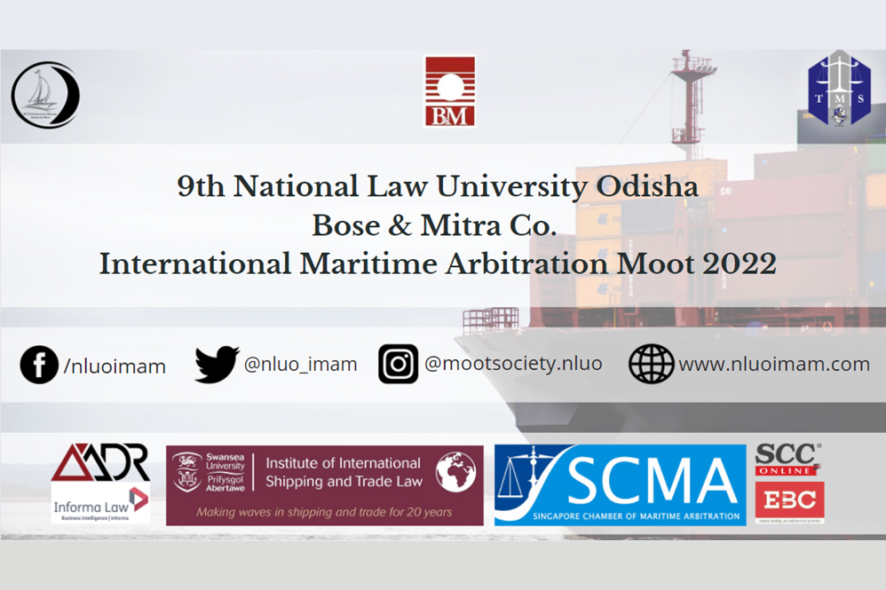For all the latest updates on the 9th NLUO Bose & Mitra Co. International Maritime Arbitration Moot, 2022 follow us on the SCC Online Blog.https://t.co/sIRzhpIgFE#nluoimam pic.twitter.com/QFdJ2YT1o6
— NLUO International Maritime Arbitration Moot(IMAM) (@NLUO_IMAM) March 24, 2022
VCR-1: 922 vs 925

VCR-2: 924 vs 910
13:42: Despite the slight delay owing to inevitable technical issues, the preliminary round 1 has started with a blast. The first speaker from the applicant’s side has started with a blast and is confidently striding through the statement of facts .
13:45: The first speaker is advocating in favour of the application of SCMA Rules and is emphasizing on the appointment of 3 arbitrators.
13:46: There’s a mix up! The speaker has quickly been stopped by one of the judges asking for more clarification on the last paragraph of the first issue, however it turns out that there was some mix up in the memo pages of the judges and the speaker has thus moved on to the next issue.
13:50: The Counsel i.e. the first speaker is now arguing on the part of negligence and has even cited an authority to substantiate his argument. The judges have not interrupted him yet and it seems that they are probably satisfied with the carefully drafted argument.
13:52: There has been a bit of confusion among the judges as it turns out that the pages of the memo sent across to them are different from the ones cited and vehemently advocated by the first speaker. Oh, this is not turning out well for now.
13:53: The second counsel on the part of the applicants has taken the floor now and is taking the judges through the third and fourth issues at hand.
13:54: The second counsel appears quite confident with the arguments and authorities she has meticulously prepared..
13:56: Well, the technical issues have crept in and the second counsel had to be interrupted by one of the judges due to audio lag.
13:58: The counsel has been shooting authorities left and right in an attempt to substantiate her arguments on the compensation amount which is to be bagged from the respondents.
14:01: The judges have been patiently heeding to all arguments of the counsel and asking for clarifications wherever required.
14:05: It’s a wrap for applicants’ arguments and the first counsel of respondents has now taken the floor.
14:07: The Counsel has now progressed to the Hague Visby Rules and is fiercely advocating for the damages and compensation over which the applicants have the right to claim. This has been followed by the prayer on part of the applicants.
14:09: The Counsel appears to be quite zealous and is citing various sections and articles of the SCMA and IAA Rules to corroborate the two-fold argument he is submitting.
14:12: The Counsel from the respondent’s side has made it abundantly clear that the Hague Rules may not be applicable and the same is not mandatory under English law either.
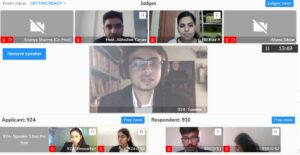
14:15: The Counsel has now cleverly picked at the intention of the parties for the application of HVR and even pointed towards the deletion of a clause in the Bill of Lading which points towards the fact that the HVR should not be made applicable.
14:18: The second Counsel from the Respondents’ side has now taken charge of the floor and with a very positive attitude is now proceeding with her arguments.
14:20: The judges have been giving out positive vibes too as they can be seen nodding their heads in approval of the arguments. The Counsel is submitting arguments on the Bill of lading in an attempt to save the actions of the defendants.
14:25: The Counsel is now steadily trotting through her 4th issue arguing on the liability and the amount of compensation along with the citation of a prominent case. There topples the internet connection of the second counsel leading to mis-communication. The judges have however sought for more clarification on the parts which were inaudible and hence unclear.
14:30: One of the judges has pointed out on excessive reliance over the addendum by the Counsel and is now bombarding the counsel with relevant questions pertaining to the addendum
14:33: The Counsel has now concluded her arguments with the prayer and has now stepped down.
14:34: Here come the tricky couple of minutes reserved for rebuttal. The Counsel of the Applicant is plucking parts of arguments of the defendant and firing questions on the ambiguous parts.
14:37: The Counsel of the Respondent doesn’t look nervous or shaken by any of the questions posed in the rebuttal rounds and is seen confidently batting away all the queries citing authorities.
14:42: The judges have now been given a separate room for deliberation on the arguments and performance of the counsels. With that, this highly enriching and wonderful session has reached its end and we hope that we get to witness many more such amazing discussions and sessions.
VCR-3: 906 vs 921
13:36: As the Arbitrator begins questioning of the counsel, the counsel handles the intensively long question in a poised manner with composure.
13:38:Another lengthy question has been thrown in the way of the counsel and yet they seem unfazed about it. Good going for them!
13:41: Arbitrator asks a pertinent question regarding the tests laid down to decide whether a rule can have mandatory or non-mandatory compliance.
13:42: After the counsel proceeded with the answer, the arbitrator seems satisfied with the response.
13:46: The arbitrators grant the counsel an extension of 1.30 minutes to conclude their last argument. Time is running out but the quality shouldn’t!
13:49: The counsel for the respondents begins with their first submission. Let’s see how they go now!
13:54: Uh-oh. The counsel does not seem to understand the questions laid by the arbitrator leading to an unsatisfied response
13:55: The arbitrator has been leading the counsel with many questions and the counsel seems baffled by the questions raised. This is not confidence-inspiring.
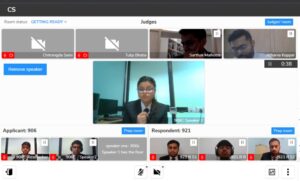
13:59: The counsel seems to recover from their dazed state and gives an elaborate response, the arbitrators too seem satisfied by the answers. Crisis averted, it seems!
14:07: Now, the second counsel for the claimant begins with their submissions.
14:12: And network problems strike! The counsel seems to be facing network issues but the arbitrators patiently repeat their queries.
14:16: The arbitrators now seem a little frustrated due to the counsel’s inability to give a satisfactory answer in response to the judges’ questions.
14:20: The arbitrator asks whether Respondent 1 can recover damages from the Respondent 2?
14:23: The arbitrators appear to be not satisfied with the response and they move ahead with more questions on deciding liability in the given issue.
14:32: The second counsel for the respondent begins with their final submissions
14:54: The counsel for claimants begin with their rebuttals now
14:57: The counsel for respondents begins with their sur-rebuttals now
14:59: The oral rounds have concluded.
VCR-4: 905 vs 904
13:32: Finally the wait is over and the oral rounds have begun in VCR-4.
13:33: The first speaker from Team 905 appears to be a little flustered with the crisp instructions of the Bench. However, she composed herself and she handled the situation wonderfully and continued with her submissions, without wasting a moment.
13:38: The first speaker continues with her submission. On being directed a question at, from the Bench, the Speaker alludes at certain provisions, which she goes on to elaborate upon.
13:39: The Bench is slowly coming into its element after a few minutes of the commencement of the session. The next thing they hurl at the Speaker is about case laws in the memorial, which the Speaker, with some hesitation, admits have not been mentioned in the Memorial at all. However, she quickly covers the faux pas up with a very similar case law. The Bench looks satisfied for the time being.
13:42: Speaker 1 concluded her first submission. The Bench had reserved a particularly tricky question for her to attack her with. The Speaker however, confidently stands by her submissions and continues defending her stand.
13:44: The Bench and the Speaker continue with a back and forth round of questions and answers. The Speaker continues to maintain her composure with utmost perfection! This is high quality stuff!
13:46: Speaker 1 proceeds to her second submission, this time with a surge of confidence after having been able to defend her stand in the first submission to the best of her abilities.
13:49: The Bench accuses the Speaker of not having mentioned the requisite information in their contract with the respondents. The Speaker, not surprisingly, directed the Bench yet again to where the relevant information has been mentioned.
13:50: But the Bench is still not satisfied. Asking the Speaker to read the provision again, repeats their question to her.
13:51: The Speaker tries to convince the Bench for 5 more extra minutes. The Bench agrees to grant her 3 more minutes, which can be increased later on.
13:53: The Speaker and the Bench are engaging on a particularly contentious point again. But the Speaker’s time is running out and the Bench continues to be dissatisfied, throwing one after another complicated question and clarification at her!
13:57: Oooopss, looks like someone is not getting along. The Bench is referring to the documents. They direct the Speaker to refer to a particular section. Both the Bench and the Speaker continues having disagreements on.
14:00: The Bench reads out the provision they are referring to, for clarity in the Courtroom.
14:01: The first speaker is confident that the Hague Rules will apply in the present situation and further consolidates her position with an English case law, where the obiter was the relevant portion.
14:03: The Bench directs the Speaker to conclude her arguments despite her pleading for a few more minutes. But the Speaker has been taking the Courtroom by storm for practically half an hour and that, as the Bench provided, was too much for one Speaker! But it has to be said that those 30+ minutes were extremely engaging and interesting!
14:04: Speaker 2 takes the floor now.
14:06: The Speaker reiterates what her co-counsel had already mentioned- the Hague Visby rules would apply. But the Bench continues having issues with their stand and directs them to specific provisions.
14:07: Oh my! The Bench declared that the Hague-Visby rules would not apply because it has not been mentioned anywhere in the problem!
14:10: The Speaker continues with her submissions with grace and confidence, refusing to be swayed by the mind boggling questions which the Bench continue to throw at her! This is brilliant stuff!
14:11: “Sub-bailment is independent from the Privity of Contract…” the Speaker continues with her well drafted arguments with flair and complete assurance in her team’s understanding of the problem and accordingly their structured arguments.
14:14: The Bench is now throwing controversial questions at the Speaker! Will the opinion of the jurist be binding on the arbitrator? What will the Speaker say?
14:15: The Speaker managed to answer the question, however, it still remains to be seen whether this Honourable Bench would be pleased with her explanation.
14:17: The Bench explains to the Speaker how the Duty of Care changes as per the situation in question. The Speaker answers that, but the Bench mentions that it is the Shipper’s duty to inform the Carrier of the value of the goods and is not the responsibility of the latter to ascertain the same.
14:19: The Speaker then pleads for 5 more minutes to clarify their position on the damages front.
14:20: The Bench however feels that this team has already taken up a lot of time! But it still relented and granted the Speaker 5 more minutes.
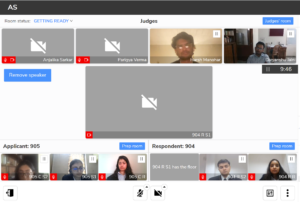
14:21: Kudos to the Speaker! The Speaker rushes to defend her stand and makes the most of the blessed 5 minutes! Despite her desperation to convince the Bench, the Speaker never once loses her composure or her cool and continues defending her stand to the best of her abilities.
14:24: The Bench directs the Speaker to conclude and get to the Prayer. The Speaker did try to snag a few extra minutes again, but this time the Bench did not budge at all!
14:26: First Speaker of 904 takes the floor now representing the Respondents.
14:29: The Bench has allowed the Speaker to keep her camera off so that they can hear her better, and indeed, at the moment the connection is stable, the Speaker has completely captivated the Courtroom with her submissions!
14:32: The Bench has a host of new and equally mind boggling questions for this Speaker as well!
14:35: The Bench demands a clarification on the number of arbitrators the parties have decided upon, since that has not been mentioned anywhere! Have the parties decided upon three arbitrators, just like they have decided upon the seat of arbitration as Singapore?
14:37: To alleviate the concerns of the Bench, the speaker tries to draw their attention to a particular case law, which the Bench flatly refused to accept, stating it as irrelevant. The Speaker however tried to convince the Bench of its persuasive value, but the Bench still does not look too convinced by that.
14:42: This Bench is extremely hard to convince! The Speaker is trying her level best to do it, but it still remains to be seen if her efforts are actually coming to her aid!
14:42: The Bench continues grilling the Speaker!
14:43: The Bench offers to make the argument for the Speaker since they are running out of time!
14:44: The Bench clarifies that the Speaker has not given them any precedence of relevance and they only make the argument which the Speaker was supposed to make.
14:46: The Bench criticizes the Speaker for arguing on points which completely contradict the Problem given to the teams.
14:48: The Speaker is granted the permission to complete her arguments entirely because of her unstable connection, after which the bench would direct questions at her.
14:54: But the Speaker is facing internet issues again and is unable to answer. The Bench agrees on directing the questions at the second speaker itself.
14:55: As a result, the second speaker takes the floor.
14:56: As promised by the Bench, they have started directing all their questions for this team to this Speaker within a minute of his taking the podium!
14:57: “Can you be discharged from the Duty of Care?” The Bench has hurled this particularly confounding question the second time in this session!
15:01: “Wasn’t it your responsibility to have a vessel that is sea-worthy?” The Bench continues with their confusing and possibly ‘difficult to answer’ questions at the Speaker!
15:04: The Speaker, with absolute confidence, argues that the liability to have a vessel that is sea-worthy is not vested in his team!
15:08: The Speaker continues with his submissions and substantiates his arguments with case laws. However, it seems the aggravating internet issues, which plagued his co-counsel throughout her submissions, are catching up with him!
15:09: Having been directed by the Bench to turn off his camera for better connectivity, the Counsel in a very self-assured manner continues defending his stand since he has a stable internet connection now.
15:11: The Speaker continues with his submissions and has the complete attention of the Bench who listen to him with rapt attention, looking for any loopholes in his arguments! From the looks of it, they do not seem to have been able to find any in 2 whole minutes and counting, which in itself is an achievement!
15:13: The Bench has formulated a question based on the new landmark judgement which was brought up by the Speaker and the bench demanded the obiter to be shared with the Courtroom.
15:15: The Bench has completed their question and the Speaker is back to defending his stand!
15:19: Looks like the Bench has been able to spot a chink in the Speaker’s armour and now they are definitely not going to let go of that easily! The back to back questions are clearly putting the Speaker under a lot of pressure.
15:21: The submissions are finally done and now it is time for the rebuttals!
15:21: The Speaker, in the same breath, dealt with the rebuttals he had up his sleeve.
15:24: Speaker 1 from team 905 is back! With her air of calm she is back to handling her rebuttals.
15:28: Now its time for the sur-rebuttals! Speaker 2 from 904 is back to address these on behalf of his team.
15:31: The rounds have concluded.
VCR-5: 919 vs 915
13:29: And it’s a go-ahead and the claimant start their preliminary round with grace and ultimate confidence with the statement of facts.
13:33: Some questions posed by the bench on the SCMA rules were confidently answered by the speaker. Let’s hope this continues!
13:36: The streak of confidence seems to have to come to an end, the judge and the speaker have different interpretations of the provisions in question!
13:38: The incessant grilling has visibly thrown off the speaker, but the show must go on!
13:42: The bench continues to grill the speaker with long questions on the first contract and the liability of the claimant
13:45: With an extension of time, the judges continue grilling the claimant on the operation of the Hague rules and the gap in the contract by the claimants
13:48: The claimant contends that the Hague Rules will take precedence over the liability clause that exists in the contract between the parties. The bench seems unsatisfied and ask for authorities for the same to be submitted.
13:54: The second speaker takes the floor now, trying to start on a fresh page with the judges. It’ll be interesting to see if they can turn it around!
13:59: The claimant elaborately submits that there need not exist a separate exclusive contract between the bailee and sub-bailee. They also refer to the submissions of the first speaker with regards to the Hague Rules.
14:03: The judges seem to be impressed with the speaker’s calm demeanor while dealing with repeated questions regarding the cases cited in their memorial
14:07: The bench is having a tough time navigating the extensive memorial of the claimant
14:10: Questions regarding the issue of liability of a third party in a contract have thrown off the speaker and the judges continue to grill the speaker on the same
14:20: The bench is frustrated with the claimant’s contentions not being quoted in their memorial. The speaker is warned and is asked to refer to the memorial for cases and rules mentioned in their submission.
14:22: The judges again have a different view of the Hague rules compared to the Claimants. The speaker is visibly affected but moves on with their submissions.
14:26: The claimant is questioned on the addendums. The bench opines that an unfair burden is being put on the respondents and that the addendums are being ignored.
14:29: The claimant tries to counter these accusations but fails to do so satisfactorily. The bench has also given up on trying to get a clear answer from the claimants.
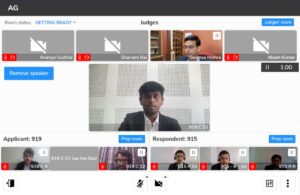
14:35: The respondent now starts to address the bench, starting off on a confident note
14:38: The bench questions the respondent on the arbitration proceedings arising out of the bill of lading, In response, the counsel cites the addendum but fails to submit why the bill of lading should not be followed. The bench says that there is no dispute at all, and even the consolidated arbitration proceeding should follow the bill of lading which is binding on both parties.
14:43: The counsel is unsuccessful in countering the questions regarding the law under which the parties are governed.
14:48: The bench questions the counsel on why the other rules regarding the appointment of three arbitrators should be ignored and why only the International Arbitration Act should apply and only one arbitrator should be appointed.
14:52:The bench is still unsatisfied with the answers given by the counsel with regards to consolidation of proceedings. The judges strongly feel that the facts will not change and will not lead to the re-laying of conditions after the consolidation of proceedings.
14:56: The counsel submits that there is ambiguity between the parties on the number of arbitrators and that there is ambiguity on which version of the SCMA rules will apply.
15:00: The respondents failed to take note of the claimants’ mistakes and did not mention the authorities in their submissions.
15:03: The second counsel on behalf of the respondents has taken the floor.
15:07: Fortunately for the respondents, the counsel continues to refer to their memorial for the efficiency of the court and to the relief of the bench.
15:10: The bench seems to be regretting their earlier relief, as the counsel fails to point out specific areas where the cases in the submission are mentioned in the memorial
15:13: The bench seems to be regretting their earlier relief, as the counsel fails to point out specific areas where the cases in the submission are mentioned in the memorial
15:16: The exclusion of the Hague Rules is pointed out to the counsel and the bench continues to grill the counsel on the same.
15:23: Despite an extension of time, the counsel struggles with the specific questions posed about the judgements cited. The bench states that the counsel’s interpretation and the tribunal’s interpretation of the judgement is starkly different.
15:27: The bench playfully mentions that time limits exist because of benches like them and are amused at the amount of time that has passed.
15:30: Despite the light atmosphere in the minute prior, the bench quickly switched focus and grilled the claimants in the rebuttals.
15:30: After also covering the sur-rebuttals, the judges seem satisfied with the conclusion of the round.
VCR-6: 909 vs 927
13:43: After a minor delay, the oral rounds have commenced. Hopefully the delay doesn’t cause any jitters or nervousness for the participants!
13:46: The judges begins their questioning the counsel about the jurisdiction of the Tribunal.
13:51:The counsel is trying her best to put forth their best arguments and satisfy the judges of their legal backing.
13:53: The judge quizzes the counsel about the difference between procedural law and procedural rules. A series of questions follow and the counsel manages to answer them, but the judges do not seem very impressed.
13:56: Oh no! The judge’s questions appears to have thrown the counsel off-track.
13:58: The speaker has been given an extra minute to conclude her submissions as she has run out of her time. She briefly summarizes her arguments.
13:59: The second counsel begins and the judges listen intently.
14:02: One of the judges is not convinced since the counsel is unable to satisfactorily respond to the questions. The counsel is once again unable to back up their claims with any credible material and is only arguing on the basis of made-up facts.
14:06: The judges listen with rapt attention, trying to gauge the counsel’s stance on the loopholes in their arguments. The counsel seems to be merely reading out her arguments as the response.
14:07: The counsel is asked to elaborate about the facts of the case that she is citing. She stammers her way through the facts, demonstrating how it is relevant with the concept of seaworthiness.
14:11: The researcher does not come to the aid of the counsel and the judges have to move on in spite of not having received a satisfactory answer.
14:13: The counsel falters and seems not very well-versed with the arguments. Time is also running out now!
VCR-6: “You’re beating around the bush counsel!” #nluoimam
— NLUO International Maritime Arbitration Moot(IMAM) (@NLUO_IMAM) March 24, 2022
14:22: The counsel for the applicant concludes after having received several extensions.
14:22: The counsel for the respondent begins. She seems confident and full of spirit! Let’s see if that continues!
14:24: Nerves getting to the counsel! The counsel is quizzed about the applicability of the UNCITRAL Model Law. The counsel falters and ends up reading the wrong section than the one that she originally intended to read. However, she recovered herself and continues gracefully afterwards.
14:28: The Honourable judges have been attempting to gain more clarity on the arguments presented by the counsel through a series of cross-questions.
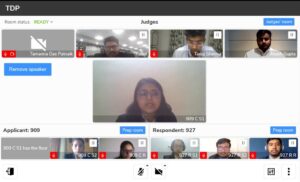
14:29: The judges do not seem very impressed. The arguments presented by the counsel do not seem to have enough legal backing – the judges suggest the counsel to concede the issue and the counsel acts accordingly.
14:31: Would hate to be in that position but it looks like the counsel for the respondent is having a hard time being grilled by all the judges.
14:37: The first counsel stands down and the second counsel takes the floor. He lays down the structure of the issue he will be dealing with.
14:45: The counsel is asked to answer some hypothetical questions. The Speaker takes his time and calmly answers the questions. The judge interrupts him with additional inquiries. The speaker then fumbles for a while before responding in the hopes that the judge will be satisfied. The judges seem to have not bought the answers and they ask him to proceed further with his submissions.
14:48: The counsel has been able to present his arguments relatively smoothly so far with no interruptions by the judges.
14:51: Decision making takes centre-stage here! The counsel for the applicant begins with rebuttals for both the merits and the procedural issues. However, before she could begin, she is asked if it is good use of her time if she rebuts the jurisdiction again. She answers in negative and the judges think that she made the right decision!
14:58: The judges think that the respondents had a plan regarding what they wanted to argue. They had a better understanding of the law, however the claimant appeared very confused about the procedural rules.
15:03: The feedback session begins. The judges stressed on the importance of being well-versed with the procedural aspects of the case.
15:08: The judges expressed their dissatisfaction about the numerous extensions asked.
VCR-7: 911 vs 902
13:46: The Applicant takes the floor and begins with their submissions.
13:50: The Judges questioned the authority and rules under which the tribunal was constituted today. The inability of the counsel to understand the question correctly led to a heated discussion between the counsel and the judge. The judge further asked regarding the several means in which the arbitrator can be appointed. The counsel being unaware of the same exclaimed that their inability to answer is due to the fact that it is not in context of the question at hand.
VCR-7: The judge, astonished regarding the same, questions, “Are you saying that I am asking an irrelevant question?” #nluoimam
— NLUO International Maritime Arbitration Moot(IMAM) (@NLUO_IMAM) March 24, 2022
13:59: After a prolonged disagreement regarding the constitution of the tribunal today, and if the tribunal should continue to hear the proceedings. The Counsel is asked to proceed to the next limb of their submissions.
13:01: An extension of 3 minutes is granted to the applicant to finish their submissions regarding Issue 1 after the speaker for the respondent has concluded their arguments on the 1st Issue
14:03: The respondents now begin with their submissions.
14:07: Counsel for the respondents gracefully answers the questions which are posed by the judges regarding the rules of Arbitration to be followed in the case today, and the standing of the Tribunal today.
14:09: The Applicant is now called upon to make their submissions regarding the issue of whether Tawe is liable to Caspian?
14:13: The submissions being made by the Applicant are well backed up with cases, and the judges seem to not question the same yet.
14:15: An extension of 1 minute granted to complete submissions by the applicant’s first speaker. After this, the submissions will be concluded for the applicant by their second speaker
14:17: The second speaker takes the floor to address the issues of compensatory damage and the damages which both the defendants are entitled to.
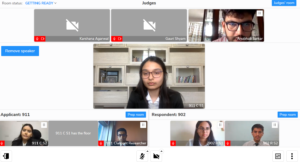
14:23: While a technical glitch hinders proceedings for a short period of time, the counsel now sails smoothly through her submissions.
14:28: After smooth sailing on the first issue. The counsel now starts with the next issue.
14:33: The judges question the counsel on the basis of the factual statements admitting that the tribunal is not one which is lawfully constituted. However, the counsel agrees that having argued before the Tribunal, it is one which stands as per law. An interesting turn takes place here as this controversial statement made by the counsel implies that they concede on the question on the formation of the Tribunal
14:38: The counsel for the respondent begins with their submissions. The counsel is confident, and is gracefully making her submissions
14:44: Having completed submissions as Speaker 1 of the respondent, Speaker 2 takes the floor to further the case for their party.
14:46: The counsel continues to make his submissions stressing on the specific phrases mentioned in the factual background and how the interpretation of those will establish their case.
14:50: With the end of the submissions, it is now time for the much awaited round of rebuttals!
14:53: As the teams had exceeded their respective time limits, a minute was granted to each team for the rebuttals and sur-rebuttals
14:55: A further extension of 30 seconds to the applicant for rebuttals enabled them to end by making a strong case for their party.
14:57: The respondents, refuting the points furthered by the applicant in terms of appointment of arbitrators as well as the liability owed by the respondent, rest their case.
14:58: The rounds ended successfully with both the teams making their submissions with utmost brevity and confidence.
VCR 8: 916 vs 926
13:42: Session 1 starts with a bang as fresh faces greet us for this afternoon session. The Claimant’s first speaker presents their narrative.
13:45: First speaker of claimant engages on the issue regarding applicability of arbitral rules to this dispute. The Judge interjects the speaker to test their understanding of corresponding laws regarding formation of arbitration panels. But the Speaker calmly explains their understanding of the same.
13:49: The speaker loses their flow due to the interjection posed by the judge on Cruze’s liability. But the judge allows them to address the question at a later stage.
13:54:The Speaker expresses a clear disagreement with the Judge’s understanding of the case. However, their explanation satisfies the Judge and they seem convinced with the response of the counsel.
13:58: The Speaker expresses a clear disagreement with the Judge’s understanding of the case. However, their explanation satisfies the Judge and they seem convinced with the response of the counsel.
14:07: Speaker 2 from claimant side addresses many of the doubts posed by the judges in the first half. The judges seem impressed with the speaker’s submissions as they note down points furiously on paper.
14:09:The judge interjects with the exception of Act of God in Article 4 to ask if liability still arises then. The speaker concisely answers that there is an admitted act of negligence committed
14:21: The first speaker of respondents’ side argues that the composition of the arbitration panel may even include a sole arbitrator considering the seat of arbitration.
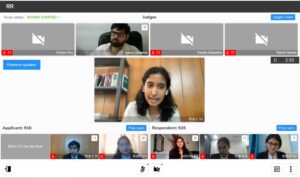
14:24: The first speaker of respondents’ side responds to claimants’ arguments that the Hague Rules don’t apply on the parties and systematically responds to each of the submissions made by the claimants.
We have come to the end of an engaging first session. Stay tuned the SCC Online Blog for constant updates!
Link: https://t.co/sIRzhpIgFE#nluoimam pic.twitter.com/u467GVZ20q— NLUO International Maritime Arbitration Moot(IMAM) (@NLUO_IMAM) March 24, 2022
SESSION 2
VCR-1: 913 vs 924
17:40: The Courtroom is set, and the teams are ready. Session 2 of the Preliminary Round has begun in full swing in the courtroom, with an unbridled enthusiasm.
17:41: The first counsel begins with a brief narration of the facts involved in the dispute.
17:43: After the narration of facts, the first counsel laid down the structure following which claimants would present their issues.
17:44: Counsel is presenting her arguments in a very assertive and yet, understanding manner. This is helping judges to grasp the presented arguments with ease.
17:51: First counsel is already done with her arguments with minimal grilling before the completion of time. Now, the second counsel has taken the baton from the first counsel.
17:52: The courtroom largely has a calm and positive atmosphere with an agreeable approach adopted by the judges towards the counsel’s arguments.
17:54: The second counsel is having an elegant bearing over his arguments but somehow it seems that he is narrating the grounds verbatim, as in reading it aloud from something
18:00: The second counsel moves to the prayer. Claimants managed to put forth their arguments in a composed and timely manner and left with a time of over 3 min
18:01: The claimants concluded on a positive note, with only a few questions from the judges. The floor is now taken by the respondents.
18:04: After narrating the facts, first counsel started with the submission of their jurisdiction towards this court. It seems that the respondents are careful of every minor detail with which they can grab bonus points.
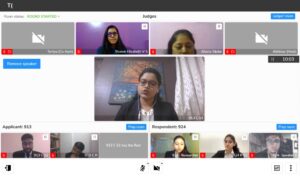
18:06: The first counsel started his arguments by relying on the particular sections of the respective act which therein bought him a series of question from the one of the judges.
18:11: The counsel is presenting his arguments by wholly focusing on the sections and specifically attracting the judges’ attention on pages of their presented compendium. In return, judges are also responding to counsel’s request in an agreeable manner.
18:13: A successful example of interaction with the judges? The counsel concluded his arguments with an ease and asked for the permission of judges to hand over the podium to the second counsel. The first counsel sets an example of courtroom etiquettes by successfully interacting with the judges.
18:17: It can be presumed that judges are getting convinced with what is presented by the counsel as there were no incoming questions from judges.
18:18: Counsel is using an effective approach in her presentation by relating each particular cited clause or rule with the facts of the present case and thereby justifying what she is presenting.
18:19: Judges found the grounds used by second counsel contradictory with what was presented by the first counsel, and questioned on the same contradiction.
18:20: The counsel fortunately convinced the judge with her explanation and proceeded with her second submission with the permission of the panel
18:21: Difference in Approach! It seems that respondents have presented their whole case on clauses and rules already existing and with a few judicial precedents, that also in the latter part. In contrast, claimants had gracefully used their cited judgements while putting forth their arguments.
18:23: The counsel proceeded with her last submission by effectively using her allotted time.
18:26: The counsel concluded her deliberations in a productive and timely manner.
18:29: As the rebuttals began, claimants are back on track, brimming with new energy and enthusiasm as they prepare to submit their arguments. They strike the very basis of respondents’ pleas and tried to negate the whole argument presented by the other party.
18:33: By taking full 5 minutes, claimants consciously highlighted every loophole left by the respondents during their arguments.
18:34: Following the intensive deliberations and minimal questioning, the courtroom is done with the rounds in the second session.
VCR-2: 920 vs 906
17:40: The stage has been set and all counsels are fiercely looking forward to submit their arguments before the esteemed tribunal.
17:41:The first Counsel has started off with impeccable confidence and is structurally covering all parts of the issues. The Counsel is building their case on the concept of party autonomy and citing authorities for the same.
17:45: The arguments are being submitted steadily without any interruptions till now, which shows that the judges have probably not been able to find any inconsistency in the arguments. The confident smile across the Counsel’s face shows that she is well-prepared and will not breakdown anytime soon.
17:48: The Counsel is now using the Doctrine of Equality to build on her case and is quoting landmark judgements for the same. Additionally, the Counsel has emphasized on the appointment of 3 arbitrators in the matter. The judges have not countered the first Counsel with any question.
17:51: The floor has been taken over by the second Counsel from the Applicants’ side now, who is vehemently advocating for the damages caused to the applicants as a result of the negligence on the part of the respondents.
17:54: The Counsel has been abruptly interrupted by one of the judges as the judge has a question on the Hague Rules. The Counsel looks shaken and a little nervous by the interruption and is fumbling for words to frame her answer. She has again been countered by another question fired from a Judge who is slowly shattering the confidence of the Counsel which was initially at its peak.
17:58: The Counsel is however seen commendably keeping her calm and slowly picking up her herself to answer the questions bombarded at her. Finally, after a pretty long discussion, the judge has been appeased with the answer of the Counsel.
18:01: The judge of VCR 2 is not one that can be easily satisfied and he has yet again impeded the pace of the Counsel by throwing more questions at her on the applicability of the Rules in the matter. These questions seem endless as the judge is constantly quoting the agreement between the parties and shooting more questions on the arrangement.
18:05: With 3 minutes left in hand, the Counsel is struggling to reach the end of her arguments and is acing her way through. There comes another question in the way of the Counsel regarding the quantum of damages claimed. The judge is reiterating his question as it seems that the Counsel was unable to comprehend the question and is babbling in a different direction. Maybe a bit of nervousness kicking in?
18:10: It’s no surprise that the time has elapsed with the Counsel still left with some parts of her arguments to be covered but fortunately, the judge has been kind enough to grant extension of a couple of minutes. Satisfying one specific judge would not be a cake walk for the second counsel as he is adamant on eliciting a response from the Counsel for a question she doesn’t have a concrete answer for.
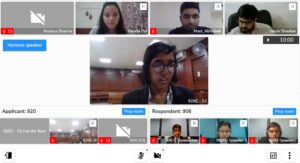
18:15: It has been over 5 minutes since the time allotted for the second counsel of the applicant’s side has lapsed and yet the arguments seem endless. She has finally been warned and given a time window of only 3 seconds to wrap up and conclude her submissions.
18:20: The mic has now been passed over to the Respondents’ side and the first counsel is presenting her submissions with utmost care and diligence.
18:22: Within few minutes of start of the submissions on the Respondents’ side, the Counsel has been interrupted by a Judge who is questioning the application of the law and rules in the instant case. The answer given by the Counsel however seems to have quenched the Judge’s thirst.
18:25: The Counsel has been allowed to proceed to the next issue after she successfully argued on the appointment of a sole arbitrator in this matter. She has cited quite a few landmark precedents too in an attempt to establish her case.
18:31: Congratulations, you got congratulated in a moot round. Now that’s rare! Owing to the judge’s streak of unlimited questions, the Counsel’s time has elapsed and yet she has been granted an extension of another 90 seconds to answer a question spun at her. She has been appreciated by the panel for the brevity and accuracy of her answer.
18:36: The floor has been taken over by the second speaker from the Respondents’ side. the oral submissions have hardly started and the judge is armed with a lot of questions which have the potential to wreck the Counsel’s basis of arguments. The Counsel has yet been able to maneuver his way out.
18:44: A few more questions balled at the Counsel and the entire direction as well as structure of arguments is shattered. The judge pointed out that the answer given by the Counsel failed to satisfy his curiosity and lacked specifics.
18:49: The Counsel has finally been able to put forth his submissions for a couple of minutes without being interrupted by the Judge and has sought permission to present his prayer but has been countered with another question. The Counsel is seen floundering in the pool of questions.
18:53: The Counsel has been granted an extension of a couple of minutes so that the Counsel can comfortably present their prayer.
18:57:The limelight has now shifted to the applicant side again for the rebuttal rounds and the Counsel is seen contending the arguments of the defendant on the ground of priority given to certain clauses over the rest.
19:00: It seems like the respondent side was caught off-guard by the applicant side with their set of questions. Additionally, the Counsel of the Respondent has been countered with questions from the judge too. The sur-rebuttal rounds have finally been concluded with a blast leaving a smile of contentment on the face of the judges.
19:05: The judges have been sent to a separate room for deliberation and all the participants are eagerly looking forward to the feedback session to hear about their performance. With the feedback session completed, this fruitful session has also come to an end. This battle has witnessed a very satisfactory end and has raised bars for all the other participants.
VCR-3: 923 vs 905
17:43: After a slight delay owing to network issues from several sides, oral rounds of session-2 have finally started and the first counsel from claimants’ side begins with their submissions
17:48: The counsel completes their first limb of submissions smoothly without any clarifications being sought by any of the judges
17:52: The counsel seems to be performing in an extremely convincing manner as there has been no questions from the judges
17:53: The judge asks the first question regarding what seaworthiness means which baffles the otherwise confident counsel but they quickly recover from it and answer appropriately
17:57: The counsel seeks an extension of 1 minute in order to conclude their submissions which was granted by the judge
17:59: The second counsel for the claimants begins their submissions dealing with issues 3 and 4 respectively
18:01: The counsel begins with their submission as to why Cruze is liable to Caspian under two laws – Contract Law and Tort Law
18:08: The counsel has been unfortunately struggling as the judges face severe network issues causing such delays.
18:11: As the judge joins back, the counsel resumes with their argument directing the panel to para 3 of the case study regarding how the loss has occured and how the duty of care has been breached by the Cruze itself
18:15: Donoghue v Stevenson makes its way everywhere! The counsel yet again focuses on the essentials of the duty of care and further moves ahead to establish the three essentials in great detail using the case law of the infamous Donoghue v Stevenson

18:20: The counsel proceeds with their last submission regarding how the damages are to be decided after getting an extension of a minute.
18:22: The first counsel for the respondents begins with their submissions regarding issues 1 and 2 respectively
18:25: The counsel draws the attention of the arbitrators towards para 10 of the issue, substantiating that IAA rules will always be considered over institutional rules
18:28: The counsel further submits that the respondents are not liable for a breach of duty, moreover they plead that firstly, the Hague rules won’t apply ex proprio vigore and secondly, even if it does it will not prevail over tailor-made rules
18:35: The second counsel for the respondent side begins with their submissions dealing with three contentions regarding the liability of two defendants
18:46: The counsel proceeds with their last submission regarding how the damages are to be decided after getting an extension of a minute.
18:47: The counsel is able to complete their submissions smoothly as no clarifications were sought by the panel.
18:59: Both the counsels smoothly concluded their rebuttals respectively and the judges look pleased.
19:25: The rounds are over as both the teams received feedback from the respective judges.
VCR-4: 925 v 919
17:32: Session started! Let’s see if the participants are as refreshed as we are after the break.
17:33: The first speaker from Team 925 (claimants) has taken the floor.
17:35: After a brief recap of the facts, the Speaker has now started going through his arguments with commendable grace.
17:39: The Speaker was proceeding with significant flair, but was interrupted by the Bench with a very basic question with respect to the moot: “Is this an institutional arbitration?”
17:40: And concessions have already started! The Speaker answered that it was an ad-hoc arbitration and not an institutional one, but when cross questioned by the Bench, the speaker conceded pretty quickly.
17:42: Even though conceding to the Bench on a point, prima facie, may seem like a sound way to save time, in reality it does just the opposite! From the looks of it, the Bench seems to have squared down upon the institutional or ad hoc point and does not seem to be in any hurry to proceed to the next argument!
17:44: The questions coming the way of the Speaker now pertain entirely to the SCMA rules – from full form of SCMA to individual provisions, the Speaker seems to be in quite a tough spot, having to address all sorts of questions only on the SCMA rules!
17:47: Every time the Speaker regains his composure, the Bench throws another mind boggling question at him on the SCMA rules! However, it should also be noted that the Speaker is maintaining his cool despite the aggressive questioning by the Bench.
17:53: The Speaker needed a little more time to make his submissions, even after taking an extra 5 minutes. It was granted on the condition that the time taken by the Speaker would be deducted from his co-counsel’s speaking time.
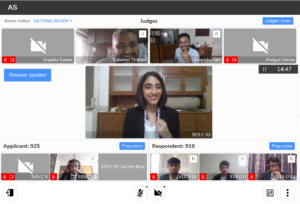
17:57: Apologies or Arguments? The Bench continues to go very hard on the Speaker, ultimately pointing out that there were more apologies than arguments from his part. It is remarkable that the Speaker didn’t lose his composure even after that particularly caustic observation made by the Bench.
17:58: The floor has now been taken by the second speaker from Team Code 925.
18:01: The Bench requires the Speaker to establish that the Hague Rules are applicable because that is something the team still needs to prove.
18:03: The Speaker seems to be struggling in the face of the calm but the Bench keeps throwing complicated questions at her.
18:10: The Bench is not cutting any slack to any speaker so far! But truth be told, the Speaker is not all that flustered with the violent questioning and seems to be handling the situation pretty well!
18:12: The Speaker was given the grant to proceed with her second submission since, as the Bench correctly observed, the first submission, subsequent questioning and the respecting replies were eating up too much of the Speaker’s time.
18:14: The Speaker requested for 2 extra minutes and was granted the same by the Bench.
VCR-4: This is IMAM, not IMM: The Bench jokingly pointed out to the Speaker that they were not in a mediation and were not under any obligation to agree with her! #nluoimam
— NLUO International Maritime Arbitration Moot(IMAM) (@NLUO_IMAM) March 24, 2022
18:19: The Speaker contended that the Hague Visby Rules are applicable, and was immediately pounced upon by the Bench who insisted that she provide a case law to substantiate her argument, going as far as to declare that they would give her the argument to her if only she could provide just one argument in her favour. Unfortunately, the Speaker argued on the point of ambiguity and couldn’t provide a suitable case law in her favour.
18:27: The Speaker proceeded to her Prayer, however, the Bench categorically declared that though they didn’t have any more questions, they were not convinced by the team’s arguments.
18:29: The first speaker from Team Code 919 takes the floor now.
18:34: Looks like the Bench has decided to give all the Speakers a particularly bad time! The Speaker tries very hard to convince the Bench of his arguments, but the Bench seems to be absolutely against everything the Speaker is trying to propose and refuses to be convinced easily!
18:39: The Courtroom atmosphere is getting more heated by the minute! The Bench refuses to see the Speaker’s point, the Speaker refuses to see the Bench’s point!
18:42: “Counsel, are we correct in understanding that you are representing both the Carriers?” The Bench asked the Speaker, to which the latter said yes. But the follow up was trickier than he expected it to be and the Bench had the upper hand right then!
18:47: The Speaker managed to get himself an extension but does not seem to be able to convince the Bench and the Bench keeps throwing more and yet more complicated questions at him!
18:55: Speaker 2 takes the floor now.
19:02: The back and forth questioning and answering continues between the Bench and the fourth Speaker of the round, which amazingly, the Speaker handles with astonishing flair and a smile!
19:09: With the arguments going strong on the sea worthiness or the un-sea worthiness, the Speaker, in the midst of all this, has managed to get an extension of 3 minutes! But looks like most of the extension time will go into the questions that the Bench is propelling at him!
19:17: The Speaker seems to be able to convince the quite well, considering the general trend of the Courtroom.
19:19:The two teams mutually agreed to not engage in the rebuttals or the sur-rebuttals, so the moot round essentially came to an end here itself. With this, we take a short break and we will be back for our third session later this evening.
VCR-5: 910 v 909
17:30: Round begins after the break with full enthusiasm in reciting the facts by the claimant
17:36: The counsel leads the tribunal through their written memorial referring to the UNICTRAL rules and the SCMA rules in particular.
17:39: The bench questions the counsel on why the SCMA rules should prevail over the other rules mentioned. The counsel is further questioned on Section 32 of the SCMA rules and its relevance in the current dispute
17:43: The counsel submits that English Law governs the contract and under English Law, the Hague Rules mandatorily apply.
17:49: Are we seeing a relay race here? The first counsel for the claimant happily passes on the questions asked to them to their co-counsel and stands down. The bench promises to ask these questions to the co-counsel. The counsel silently wishes luck to their co-counsel to deal with the bench’s grilling!
17:52: The co-counsel takes forward the enthusiasm shown by the first counsel and begins with their submissions
18:00:The counsel is questioned extensively on the applicability of the Hague Rules on states that are not party to these Rules. The Bench opines that even if the parties intend for the Hague Rules to apply, if the countries are not party to these rules, these rules cannot apply.
VCR5: Internet Explorer in Courtroom? In an amusing situation, the counsel pauses for 30 seconds while answering a question and the judges ask the counsel if they are waiting for their internet page to load to answer their question! #nluoimam
— NLUO International Maritime Arbitration Moot(IMAM) (@NLUO_IMAM) March 24, 2022
18:10: The counsel is questioned on whether the addendums were not approved by the claimant at the time of the contract.
18:14: The counsel for respondent is visibly nervous after the thorough grilling of the counsels for respondents. They begin regardless.
18:20: The counsel’s fears have come to life, where the judges have grilled them on where the procedural law prevails over the procedural rules. The counsel stands down having three minutes of time left.
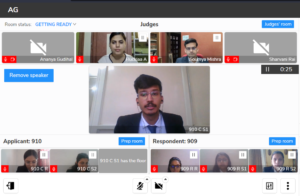
18:24: The counsel on behalf of respondent seems more confident, and deals with the issue of applicability of the Hague rules.
18:26: The counsel carries on the streak and deals with questions calmly and submits relevant authorities to the bench.
18:33: After three minutes of confusing questioning and equally confusing answers, the judges finally understood the submissions of the counsel with regards to the applicability of the Hague rules. The judge laughingly praises the counsel for their language.
18:40: The counsel seeks an extension of 3 minutes to conclude their submissions.
18:45: The claimants now proceed with the rebuttals after a heated 5 minutes of grilling by the bench.
18:50: The round concludes peacefully, with calm sur-rebuttals by the respondent.
VCR-6: 921 v 911
17:32: Welcome back from the break! The rounds have commenced on time!
17:33: It’s not even been 2 minutes and the judges have already begun a line of questioning on the amount claimed and on the facts of the case.
17:35: The counsel has begun presenting his points and in spite of being questioned about the case’s complexities, he proceeds with confidence.
17:40: Troubles brewing already? With unfettering zeal, the counsel explains how there is a liability on the part of the first defendant to provide a seaworthy vessel. However, after the judges pointed out the loopholes in the legal arguments put forth by him, the counsel’s initial confidence seems to be fading.
17:43: The counsel relies extensively on the Hague rules. Time seems to be running out when the counsel is asked to read a specific rule. The judge steps in and saves the day by saving precious few minutes by reading it himself.
17:45: With just a few seconds left, the counsel attempts to redeem himself by presenting all the relevant Hague rules at his disposal to make his case stronger.
17:48: The Hague rules have a central role in the counsel’s arguments. The judges’ questions pour in and they seem satisfied with the counsel’s answers as he argues his way through all of these questions.
17:52: The second speaker takes the floor now. He first states that he will establish that being a sub-bailee, the second defendant was under a contractual obligation to provide a seaworthy vessel and then that they are not exonerated from their liability.
17:54: The judges pointed out and asked the counsel about numerous legal technicalities, prompting him to come up with a number of compelling arguments. The counsel provided detailed responses to the judges.
18:04: The judges posed multiple questions to the counsel regarding how hurricane is not a common weather phenomenon which were answered by the counsel in a not a very convincing manner.
18:06: The counsel seems perplexed after being questioned on the concept of seaworthiness. The counsel concedes.
18:09: Just like the first counsel, the second speaker also speaks extensively about the applicability of the Hague rules. When asked about unilateral incorporation of a specific rule, he contends that it was incorporated by the consent of all parties.
18:11: Having exhausted his time, the speaker was granted an extra minute by the judges to summarise his arguments.
18:12: The counsel representing the respondent begins.
18:17: The counsel seems unfazed in spite of being grilled by the judges about the crux of her contentions. She succeeds in maintaining her calm demeanour and the judges seem satisfied by her answers so far.
18:18: The counsel puts forth her arguments. The judges do not seem all that convinced right now with these arguments and ask her to move on to the second issue.
18:21: The counsel has been confident in her responses, and the judges have been impressed by her advocacy skills, but the legal technicalities of her arguments have been questioned.
18:24: The counsel starts rushing, given that her time is going to be exhausted soon.
18:25: Time has run out but looks like the counsel cannot escape the judges’ grilling without giving satisfactory answers.
18:26: The counsel continues citing cases although her time is up. The judge interrupts her to question which clause will prevail in the Combicon bill of lading.
18:29: The counsel seems to be unsure about a specific case but her teammates come to her rescue and she gets back on track with her line of argumentation.
18:31: The second counsel steps in to proceed with the rest of the arguments. She starts with establishing how she will be advancing her arguments.
18:32: Wrong Name but Right Arguments! The counsel is thrown off by the questions and addresses herself as the counsel for the claimant. She is corrected by the judges and is visibly nervous.
18:34: “Your stance is conflicting”, the judges point out. The counsel justifies this by stating that there is a printing mistake in the memorial. The judges do not seem impressed at all.
18:37: The rounds come to an abrupt halt since one of the judges faces technical difficulties and loses his network connectivity. The counsel sees this as an opportunity to skin through her arguments again to ensure that she’s thorough in all of them.
18:40:The counsel doesn’t seem very confident. The judges are also not on the same page with the counsel and question her further.
18:41: The judges don’t seem to be convinced by the counsel’s arguments. ‘There is a clear breach of your obligations!’ Nevertheless, the counsel tries her best to stand her ground.
18:45: The counsel is unable to substantiate her points very strongly. The judges do not seem to find credibility in her legal representations. The judges also have to patiently explain several questions to the counsel since she’s unable to comprehend them promptly.
18:46: The speaker is clearly struggling and having a tough time coming up with relevant cases to substantiate her case. She informs the judge of the lack of availability of any.
18:50: The counsel comes to the end of her submission. The judges do not seem impressed.
18:51: Somebody has been attentively listening to the respondents! The rebuttals begin. The counsel ruthlessly decimates the credibility of the respondent’s arguments. There is a lot of debate on whether the word ‘shall’ should be interpreted as ‘must’ or ‘may’.
18:53: The sur-rebuttals seem rather dull as compared to the rebuttals. The counsel herself does not seem very sure about them and takes a fairly large amount of time to put a single point across. A lot of questions were left hanging.
18:56: The judges discuss the shortcomings of the legal arguments put forth by the teams in order to be able to provide detailed feedback to them.
19:00: With this, the judges gave valuable feedback to the participants and we reach the conclusion of the second session of today’s oral rounds
VCR-7: 904 v 916
17:30: Welcome back everyone! It sure seems like the applicant has come refreshed as she begins with her submissions regarding the formation of the Arbitral Tribunal with very high energy.
17:32: The first question which comes the way of the counsel is the dilemma between applicability of SCMA Rules or International Arbitration Act in the present case. The counsel handles the question beautifully, while pointing towards cited authorities to back her arguments.
17:42: Due to the paucity of time, the counsel is asked to summarise her arguments in 30 seconds. The bench appears to be adhering to the time strictly now.
17:43: Co-counsel takes the floor. He first addresses the question regarding liability of defendant.
17:45:The counsel submits that Hague rules takes precedence over any other contractual obligations. When asked to present authorities for the same, the counsel was confidently able to convince the Tribunal with the cited judgement.
17:48: Inconsistencies cropping up! While the first speaker submitted that the contractual obligations will prevail over the law, the second speaker stated that the law prevails over the contractual obligations. The Tribunal questions on the standing of these contradictory statements being made by the counsels for the Applicants.
17:50: Having beautifully argued to clear the position of the Applicant party on the contradictory statements made before, the counsel proceeds to the next argument regarding the damages to be paid by the defendant to the aggrieved Applicant.
17:53: The Tribunal puts forward a tricky question as to why the Applicant wishes to seek restitution as a damage and not compensation. As a reply to the same, the counsel explains the same by clarifying that they are seeking restitution ad integram as a remedy.
VCR-7: “Arbitrators are creatures of contracts” exclaimed the Tribunal. He stressed on the fact that they do not have power to strike down obligations like a court.#nluoimam
— NLUO International Maritime Arbitration Moot(IMAM) (@NLUO_IMAM) March 24, 2022
17:58: The counsel submits that the other Tribunals have struck down provisions previously, and so the present Tribunal must consider the same with respect to the liability limitation clause and ordering for the appropriate remedy.
17:59: Continuing to stick to the time limit, the counsel is asked to briefly conclude his submissions in 30 seconds.
18:01: The speaker for the respondent begins with her submissions. She first submits that the International Arbitration Act prevails over the SCMA Rules. The Tribunal questions on the unclear stance of the counsel on the number of the arbitrators and the default position of the law with respect to the rules which will prevail to govern the issue. The counsel is visibly perplexed, and is unable to convince the Tribunal regarding her submissions.
18:08: The counsel assures that if left with time in the end, she would return to the queries of the Tribunal on this issue and would be more than happy to assist the Tribunal.
18:09: The counsel now proceeds to the next issue on the question of liability.
18:10: The Tribunal questions one of the authorities cited by the counsel pointing that the case being cited is a bit different than what the counsel states. The speaker clarifies the same, and comfortably moves forth with her submission.
18:15: Proceeding further, the counsel now moves on to the question of the quantum of damages. For the same, reliance is placed on the Hidalgo Bill of Lading.
18:17: The counsel rests her case, and the co-counsel takes over. She begins by addressing the conflict of laws in the present case.
18:24: The counsel sails smoothly to her last submission regarding the liability of the defendants and the quantum of damages. She is able to establish her argument with appropriate authorities.
18:30: Further substantiating arguments for the respondent, the counsel concludes by establishing that Bill of Lading overrides the Hague Rules.
18:32: The rebuttals begin by the Applicant outrightly refuting all the arguments given by the Respondents. The rebuttals made were to the point, and catered to all the submissions made previously by the opposing counsels.
18:38: The respondent party, in their sur-rebuttals, relied on the seat of arbitration being Singapore and therefore establishing that International Arbitration Act will be applicable. The counsel also clarified that they are not arguing the complete non-applicability of the Hague Rules.
18:39: The rounds ended successfully with the parties having presented their arguments to the best of their abilities.
VCR-8: 918 v 922
17:37: The judge starts with a question on whether the tribunal has locus standi but the speaker refuses to engage on the question and instead continues with their submissions. Quite a nervous start to the rounds after the break.
17:42: The counsels have a long way to go! The judge interjects with another question asking whether this is a validly constituted panel and can thus hear the dispute. A long pause ensues. The panel looks to be quite a tough one to impress.
17:44: Buckling under pressure? After bouts of complicated badgering by the panel, the speaker is finally forced to concede on the first issue.
17:49: The first speaker from applicant’s side finishes 5 minutes before time. Were they in some sort of hurry?
17:56: The second speaker engages in a classroom discussion of tort law and bailment in contracts eliciting a critical look from the panel.
18:12: The first speaker from the respondent side argues on the issues of composition of arbitral panel, and whether they are liable for maintaining seaworthiness of vessel. The bench appears to be not asking that many questions in stark contrast to the first half of the round
18:19: The second speaker argues on issues of their limited liability and quantum of compensation. The counsel’s constant requests for permission to move on to other issues elicits a mildly annoyed response from the panel.
18:27: The Applicants present their rebuttals and try to undermine the respondents’ arguments but the panel seems unsatisfied.
18:29: The respondents present their sur-rebuttals laced with accusations on the applicants marking the end of the rounds.
Greetings!
The excitement continues with the second session for Day-1! You can follow the live updates of the rounds on SCC online blog. https://t.co/sIRzhpIgFE#nluoimam pic.twitter.com/ZpkvRiHDTr
— NLUO International Maritime Arbitration Moot(IMAM) (@NLUO_IMAM) March 24, 2022
SESSION 3
VCR-1:911 vs 906
20:06: The Courtroom is set, and the teams are ready and we are back with Session-3. The Preliminary Round has begun in full swing in the courtroom, with an unbridled enthusiasm.
20:07: The first counsel started by laying down the structure of their submissions before proceeding with substantive arguments
20:08: The counsel presented her submission concerning the jurisdiction aspect of the case and found herself in the series of questions from one of the judges of the panel.
20:11: The first counsel answered the questions and clarified the doubts of the judge in a graceful manner as if she was waiting for the particular question to be asked upon and it seems that the counsel is succeeding in convincing the judge
20:13: After laying down the factual as well as the statutory context for her justification against the question, the counsel puts forth her arguments by citing the judicial precedent too which further shows her preparation level for the incoming questions.
20:16: One of the judges is busily endeavoring to analyze the arguments of the counsels, and pouring the questions on factual context as well as on the legal context.
20:17: Without losing her calm, the first counsel is consciously listening to every question and gracefully responding by putting their grounds
20:19: TIME’S UP! Despite maintaining the upbeat atmosphere in the courtroom while putting forth her arguments, the first counsel loses the stance over her time liberty and now time is up.
20:20: One of the judges seems to be very impressed with the answers and the clarity of concept displayed by the first counsel. They further gave her extra time of 2 minutes to complete her argument.
20:22: Despite the time being up, questions still remain and the judge is now interrogating the counsel by asking them a series of questions in rapid succession. Meanwhile, the counsel does well to retain her composure.
20:24: Counsel further got the extension of 2 minutes and by relying on the judicial precedent, she tried to clarify the inquiries put forth by the judge.
20:26:The counsel concludes on a positive note, with the series of questions from one of the judges. The floor is now taken by the second speaker.
20:28: The second Counsel is presenting her arguments in an assertive manner by relying on the clauses of the particular act. This was immediately followed by questions from the judges, asking her to justify her state in the present case.
20:30: The counsel is confidently answering the enquiries of the judge. She is able to stay calm and composed in the courtroom and it seems like nothing can faze her right now.
20:32: The counsel is further enhancing the status maintained by the first counsel by deliberately answering each and every enquiry. The claimants may end up retaining some bonus points from judges for this significant improvement in courtroom ethics.
20:35: One of the judges seems to be satisfied with the presentation of her grounds and asked her to proceed with the second argument. But the point which isn’t get noted is that the second counsel asked to proceed with the “second defense” which if marked by judges can cost her points.
20:38: One of the judges encircled the second counsel with an array of questions and asked her to put forth some clarity in her arguments
20:40: TIME’s UP and the second counsel did not ask for an extension of time.
20:44: The second counsel is clarifying each and every enquiry of the judges in a balanced and prepared way. After intensive deliberations and questioning from the judges, the second counsel successfully completed the claimants’ case.
20:46: Respondents have now taken the podium and they have started presenting their stand in an elegant and professional manner.
20:47: The Respondent speaker has stated in a self-assured manner but the judges have been fairly active in asking the questions.
20:49: First counsel presented her answers in an assertive manner and deliberately attracting the attention of judges towards her assertions.
20:53: Fantastic display of composure! The way the first counsel is handling the incoming series of questions from the judges, it is reward worthy!
20:56: The Counsel is well versed with the judicial precedents as well as the clauses of concerned Act concerning her case. This can be seen with her elegant bearing and command over the arguments she is presenting.
20:59: The judges asked the counsel to repeat her stance over SCBA rules, to which Counsel presented her position ended with the satisfaction put forth by the judge
21:01: Counsel finished her part of arguments and asked the second counsel to take the podium.
21:02: The second counsel started his grounds by specifically clarifying the set of issues he will be dealing with, which further added to the clarity in response to the questions posed before him
21:04: Judge asked the second counsel to put his stance over ‘Special Clause’ aspect.
21:06: The counsel moved towards his grounds with the level-headed bearing in his assertions and victoriously satisfied the judge in his inquiries.
21:08: The counsel seemed very focused on whatever enquiry is put forth by the judge and preventing himself from missing the track of conversation.
21:10: The counsel is deluged with a number of question but he is still maintaining his calm and has not fazed out with questions coming in from all directions.
21:11: Before answering any question, the counsel makes sure that he understood the concerned context that the Judge has asked him to deliberate upon by repeating back the question of judge in a succinct way.
21:13: The Counsel proceeded toward his third ground by pleasing the judge with his stand after questions were raised regarding that ground.
21:18: The counsel seems to be very clear in his arguments and he is constantly trying to make the judge understand his points.
21:21: Time’s up! But the Counsel is engaged in presenting his stake and has managed to convince the judges to recognize his stance, without asking for time extension. Clever way of bargaining time, we must say!
21:24: The counsel completed his arguments but the queries of one of the judges isn’t completed with their questions. This is making this round more and more interesting.
21:26: We will now move on to the rebuttal and sur-rebuttal session following some very thorough deliberations and counter-questioning.
21:31: Rounds have been completed successfully. Judges have gathered in the judges room to discuss the marking scheme and feedback that will be provided to both teams.
VCR-2: 916 vs 905
20:05: The battle round 3 has begun with the first counsel from the applicant side taking the lead and is presenting the facts of the case concisely. She has now proceeded to challenging the number of arbitrators that should be appointed in this particular case.
20:09: Things have kicked off to a rocky start! The Counsel is carefully framing her arguments however the judges find the authorities cited vague and demand for more particulars and specifics of the authority. The answer given by the Counsel seems to leave the judges baffled and they seek for more clarification but seem disappointed given the ambiguity of the answer.
20:14: The judges look in full form and are prepared to throw questions at the Counsel. The Counsel has now been interrupted by the judge on the Liability and quantum of damages on the basis of HVR. The Counsel seems impatient to conclude her submissions and pass the baton to the second Counsel.
20:20: The baton is being carried by the second Counsel who is steadily walking through her arguments carefully drafted on the liability as set out under the Hague Rules.
20:25: The Counsel is now aggressively and firmly advocating for the applicability of the HVR in the particular case citing certain English law cases along with the Bill of Lading which mandate the applicability of such rules .
20:28: The issue of the quantum of damages as claimed by the applicants is now being presented and pondered upon. The judges have not yet interrupted the Counsel to counter any of the arguments made so far by the second counsel. There comes a query, every now and then, from the judges who are questioning the entire basis of damages claimed given that the market value has not been specified anywhere.
20:34: The time period allotted to the Counsel has come to an end but her spirit has not. She has sought an additional time window of 30 seconds to wrap up her arguments and has successfully completed the same.
20:37: The focus has now shifted to the Counsel of the Respondents who is briefly outlining the arguments and issues she intends to cover in the time allotted to her.
20:40: The Counsel is seen quoting an English judgement to emphasize on the venue or seat to be taken for this particular case. The judges however seem a little put off by the reliance of the Counsel on a particular authority which has thoroughly confused them.
20:48: The floor has been passed on to the second counsel now who is primarily arguing on the quantum of damages for the second defendant claiming that the Hague Rules cannot be made applicable and cannot be made mandatory either.
20:54: One of the judges has taken the lead and posed a question on whether the parties can contract out of the Bill to which the counsel answered in negative.
20:58: The counsel is harping on a landmark precedent which is quickly countered by the judge who does not seem satisfied with the details of the authority of the case and is demanding for more. The counsel does not have a prompt answer to the question and has requested for a minute to get back on it.
21:03: There is a creative turn in the course of submissions presented by the Respondents’ counsel who is extensively talking about implied consent of the parties involved in the case.
21:05: The Counsel is not limiting her arguments to just her memorial but is urging the judges to refer to the memo of the claimants too and is contending the same on the basis of lack of fact and proof. Additionally, the Counsel has come up with the answer to the question which was posed to her earlier by one of the judges and the same has been satisfactorily accepted by the judge.
21:08: The battle of rebuttal has commenced where the Counsel of the Applicants is firing at the Respondents saying that their stance is not clear and that they are just shifting blame to save their side.
21:11: The respondent side seems to be well-prepared with answers to the queries put forth by the claimants in the surrebuttal rounds.
21:15: The verbal battle between the parties has come to an end but the judges are in a fix deciding which side outweighs the other. There is no denying that both the sides put foth their best cases and fought tooth and nail to grab a place for themselves. With that, we come to an end to first enthusiastic day of the preliminary rounds of 9th IMAM. We hope to see the participants fight out their sides with more vigour and energy in the following days of the event.
VCR-3: 919 vs 922
20:08: The counsel for the claimants begins with their submissions stating the four contentions they will argue upon.
20:09: The judge asks the counsel to summarise the facts of the case in only two minutes
20:10: The judge asks the counsel regarding what further steps they will take if this particular issue regarding the arbitration fails. This fazes the counsel into utter and shocked silence
20:13: The judge continues with their query by asking for clarification regarding the definition of substantive law its distinction from procedural law. Much to the disappointment of the judges, he counsel could not deliver a satisfactory answer
20:16: The judges do not agree with the interpretation of the statute quoted by the counsel with no further substantive backing. In response, the counsel pleads to respond to this question later.
20:18: Due to the paucity of time, the counsel skips to the last limbs of their argument regarding deciding the liability of the defendants
20:19: The judge asks the counsel to relay their arguments primarily on the facts of the case rather than the law backing it up
20:21: The counsel seems unfazed even after the chain of questions put forth by the judges and the counsel smoothly puts forth their last limb of submissions
20:23: The judge continues to question the counsel regarding the facts of the issue about the diligence of the claimant itself. This throws off the counsel and the counsel is visibly shaken because of this intervention by the judge.
20:26: Who am I representing? What am I doing? The counsel is unable to respond to the question asked by the judge regarding who the counsel is actually representing – defendant 1 or defendant 2
20:27: The counsel makes a final attempt to satisfy the judges after getting a considerable period of extension in addition to the allocated time
20:29: The second counsel for claimants makes their submissions regarding issues 3 and 4 respectively.
20:31: The counsel attempts to establish sub-bailment in order to establish liability and the judges seem to consider this response satisfactory
20:33: The counsel furthers their submissions stating that the burden of proof is on the defendants in this particular case citing the Hague rules. However, the judges ask for more clarification as they are not convinced with the counsel’s argument.
20:36: The counsel stands confident amidst a chain of questions thrown in their way by the judges
20:37: Even after several attempts made by the counsel to establish the relevance of the Hague Rules in the two bill of ladings, they fail to give a satisfactory answer to the judges
20:39: The judges continue to quiz the counsel regarding the particular clauses mentioned in the bill of ladings
20:53: The counsel clubs the multiple questions asked by the judges regarding the need for a sole-member arbitration tribunal but fails to provide any merits for their arguments
20:57: The judge points out towards the contrasting arguments provided by the counsel regarding the SCMA rules and Hague rules which throws off the counsel a bit
21:00: The judge asks the counsel regarding the doctrine of approbation and reprobation but the counsel was unable to answer
21:06: The arbitrator asks the counsel to provide for a similar case where the Hague laws were not applicable to which the counsel responds with detailed arguments stating two precedents but the judges do not consider it as a satisfactory answer and consequently continue to quiz the counsel
21:09: Even after several attempts to clarify their arguments, the judges still consider the counsel’s case weak and contradictory to some of their own contentions
21:13: The second counsel for respondent begins with their submissions
21:21: The judge asks the counsel to state the relevance of the specific clauses given in the bill of lading. In response, the counsel managed to give a satisfactory answer
21:23: The counsel directs the panel’s attention towards the case study to point out when exactly the loss occured which resulted in no liability for Respondent No. 1
21:24: The judges though, do not agree with the counsel’s argument, as the counsel could not establish that they are to exonerated of the liability
21:26: On a lighter note, in response to the counsel’s defence that even if they are liable it will only be limited liability and that too, be considered as a sympathetic act by the respondents, the judge mentions that there is no room for sympathy in a courtroom
21:33: The counsel takes the judges through the last limb of her submission stating that they are not liable to pay for any of the converters as they have already reached agreement as per the mentioned contract
21:35: The Judge reviews the 2 questions asked to the first counsel for claimants which they were unable to answer before and they seem satisfied with the counsel’s response now
21:43: The counsels from both the sides conclude their respective rebuttals
21:50: That’s it for today. We will see you again and we will provide even further updates from tomorrow afternoon onwards. It’s bye-bye for today but with a promise to meet again tomorrow.
VCR-4:909 vs 924
20:05: Aaaanddd we are back with Session 3 of the first day here in VCR-4 of IMAM 2022
20:05: The first speaker of team code 909 has taken the floor and he is straightaway briefing the bench about the facts
20:09: Speaker 1 has dived into her submissions, but unfortunately, no small detail ever escapes the sharp vigilance of the Bench. The questions, as is naturally expected, have also started along with the submissions!
20:16: The Speaker continues with her submissions, while the Bench throws an occasional clarification and question at her.
20:18:The Speaker has concluded her submissions only to be met with the dissatisfied remark of the Bench that their question has not been answered.
20:20: Speaker 2 has taken up the floor now, taking up from where her co-counsel ended.
20:25: Speaker 2 continues with her submissions while the Bench keeps questioning her. Sea worthiness being the centre of discussion in the Courtroom at the moment, the questions and answers mostly revolve around that point.
20:36: The second speaker has almost concluded her present submission, but the Bench keeps throwing innovatively complicated brain teasers at her!
20:39: The Bench requires the Counsel to corroborate her present argument with her written submissions. The Counsel, however, was unable to present the same in her written submissions, thereby inviting a “Why should we listen to you when it is not there in your written submissions?” from the Bench.
20:42: The Speaker has concluded her submissions.
20:46: Speaker 1 of Team Code 924 has taken the floor now.
20:52: The Speaker is going strong with his arguments and has captivated the Bench with a relevant case law that he is citing pertinent to his case.
21:00: The Speaker continues with his earnest efforts to convince the Bench, but the Bench will not be swayed that easily. To make things even more interesting, the Bench is actually giving the Speaker a factual situation as an example to better understand his argument and simultaneously making him apply the logic of his argument to their factual situation!
21:02: The Speaker has been given the permission to continue with his submissions when the Bench declared that they weren’t convinced, despite the counsel’s best interests
21:09: The heated exchange continues. The Bench questions the Speaker on what he meant by the General Principles of Contractual Construction, when the former made a reference to that, but when the Speaker was unable to answer to the satisfaction of the Bench, the latter made the very pointed accusation of the Speaker squandering the time of both the Bench as well as the Speaker himself.
21:15: The second speaker of Team Code 924 takes the floor.
21:27: The Speaker tackles all the questions coming her way without skipping even a heartbeat!
21:30: The Bench continues to throw all sorts of questions, and while the complexity of the questions does not go down, the Speaker manages to handle all the questions to the best of her abilities, with impressive grace and incredible self assurance!
21:37: The Speaker has run out of time, but looks like she had more to say. But unfortunately, even her extension has run out!
21:38: The Bench does not feel there is any need of any rebuttals anymore, and the teams did not have any specific rebuttals to make either, except for a clarification from one team which the Bench addressed.
21:39: With this, the round comes to an end for today. We will tune in again from tomorrow afternoon! Cheerio!
VCR-5: 927 vs 913
20:03: The last preliminary round for the day starts with a bang and the judges seem excited for the submissions by the participants. Whether it is because it is the last preliminary round for the day or for the grilling of the counsel, we will never know.
20:06: It seems to be the latter, as the judges within three minutes have managed to question the very premise of the counsel’s submissions.
20:10: The counsel is extensively questioned on the seat of arbitration and Rule 32 of the SCMA Rules.
20:18: Although the bench seems dissatisfied with the counsel’s submissions on the applicability of the Hague rules, the counsel’s knowledge of facts have apparently impressed the judges.
20:21: The co-counsel begins the submissions and tries to keep up with the flow that their co-counsel had set 15 minutes earlier.
20:24: The bench questions the counsel on the liability of the sub-bailee to the sub-bailee. They are further questioned on the master-servant relationship between Tawe and Cruze.
20:30: Immediately after the counsel’s answer, the bench nudges the counsel towards the right answer but the counsel doesn’t take the bait.
20:32: Face-Palm! The bench is visibly frustrated, with both of them face-palming at the counsel’s answers.
20:38: The counsel then proceeds to make their submissions regarding the unseaworthiness of the ship and the issues of due diligence
20:45: The counsel is inching towards the right answer, but fails again. The bench continues to grill the counsel on the limitation of liability.
20:51: The counsel for respondent begins with their submissions now.
20:54: The bench questions the counsel on the contradictions between the application of the Hague Rules and the limited liability clause being valid.
20:59: The counsel answers questions regarding the applicability of Equity under English Law with regard to duty of care and the absolute denial of relief to the claimant
21:03: The bench continues to grill the counsel on the basics of the addendums and the Hague Rules.
21:10: After repeated questioning on whether the addendums will prevail or the Hague Rules, the counsel took the bait and changed their answer. The bench then grilled the counsel on the new answer after observing the change in their stance.
21:16: The co-counsel for the respondent begins the submission of their issues on arbitration.
21:20: The bench questions the counsel on whether the SCMA rules deal with multi-party arbitrations, like the current dispute before the tribunal.
21:25: The SCMA rules and the procedure laid under it has been extensively discussed back and forth by the judges and the counsel with regards to the number of arbitrators to be appointed. The bench concludes that there is no inconsistency between the parties’ agreement and the SCMA Rules.
21:31: Despite the late hour, both the bench and the counsel seem as enthusiastic as ever. The counsel refers to the breach of contract as a draconian effect. The judge remarks that a draconian effect only applies to society and not a commercial contract.
21:37: The bench grills the counsel on the damages that they claim to not have liability for.
21:45: The respondent post conclusion of submissions thanks the bench for a patient hearing and kind questions. The bench playfully remarks that it was an honour troubling the counsel with questions
21:49: The counsels move forward with respectful rebuttals and conclude. The bench also spares the counsels from grilling in the rebuttals.
VCR-6: 915 vs 918
20:03: Welcome back! The rounds have commenced after a short break! We hope that the judges are feeling refreshed as well
20:05: All of the teams are ready to put forth their arguments with renewed vigour and enthusiasm.
20:08: The judges were finally able to locate the case. However, precious time has already been lost in what could otherwise be considered to be a fairly simple point to get across.
20:11: The counsel was asked to skip this on the issue on the basis of kompetenz-kompetenz and move on to the next issue.
20:15: With the competition proceeding, we can see the counsel asking the judges several times to refer to the memorial which results in time running out.
20:17: Slowly and steadily, we are getting there as this round has proceeded at a rather slow pace till now.
20:19: Exactly one minute was granted to the counsel to summarise the rest of his submissions. Flustered, he attempts to condense months of research into a few sentences to convince the judges in his favour.
20:21: Just as he concludes, he is quizzed about the Hague rules and whether or not they have the force of law. His request for extension is also denied while the judges do not look very convinced with respect to his arguments.
20:22: Speaker 2 joins to address issues 3 and 4.
20:25: The speaker takes the help of case laws to assert that damage could have been avoided had the respondent provided the seaworthiness of the vessel.
20:26: The counsel directs the attention of the judges to the wrong page numbers. Again, precious time is lost looking for specific citations.
20:30: The speaker faces a bout of questions regarding the agreed terms between the claimant and respondent.
20:34: Albeit not very skillfully, the counsel manages to answer the judges questions. The rounds proceed with the counsel seeming dazed throughout. The counsel again makes the mistake of mentioning the wrong citation. Wrong Citation? We have all been there!
20:36: The judges deny granting the counsel one and a half minutes more. They ask him to wrap it up within a minute. The counsel makes it evident that he’s not happy about it. ‘But I have to conclude one more issue!’ The judges do not seem at all impressed by this behaviour.
20:39: The speaker appears to be confused on the connection of the Mucaster Castle case in light of clause 15, but shifts his attention to another area of the argument in an attempt to satisfy the judges. Despite being subjected to a lot of criticism on this topic for a long time, the speaker maintains a cool demeanour.
20:42: Before she could begin, the first speaker of the respondent is quizzed about the legal technicalities. However, she is unable to hear anyone due to internet issues. The judges allow her to give a monologue.
20:45: Due to exceptional circumstances, the speaker is allowed to proceed with her arguments with only minimal questioning by the judges at the end.
20:53: The counsel seems to be clueless about her arguments. She stops midway and loses her train of thought. As a result, the judges are visibly not happy with him.
20:56: After a rather lukewarm 12-minute segment in the round, the counsel finishes her submissions with time to spare. The researcher is asked to convey the questions of the judges to the speaker.
20:57: The second speaker commences arguing the final two issues.
21:02: The judges are listening intently to the speaker and ask her to shed some light on the loopholes in her arguments. The counsel answers them coolly and proceeds without any stutter.
21:07: The counsel stammers quite a lot while answering the questions posed by the judges. She doesn’t sound very convincing and appears to be unsure about her arguments.
21:08: The counsel is extremely nervous and desperately attempts to calm her nerves in order to be able to answer the question coherently. She is unable to explain why Tawe is liable if they are not privy to the contract.
21:11: Flustered because she’s unable to satisfactorily answer the judge’s questions, the counsel is told ”You have wasted our time, why should we not impose damages on you?” The counsel stammers her way through the few sentences that she manages to speak
21:13: The judges remind the first speaker of the respondent that she is yet to answer their questions. After apologizing for the technical glitches, she proceeds to defend the respondent.
21:16: We proceed to rebuttals and sur-rebuttals. The counsels are informed that there is a constraint of time. However, they fail to keep them restricted to relevant points only and are interrupted midway due to the same for a series of questioning.
21:21:The counsel for the respondent chooses to tell the prayer instead of opting for sur-rebuttals.
21:22: The counsel insists on the panel giving her additional time to present her sur-rebuttals after her prayers. The judges deny the request.
21:23: The judges deliberate among themselves in order to be able to provide feedback to the participants.
21:25: We have reached the last stop of the day. All the rounds of the first day have concluded.
VCR-7:926 vs 923
20:01: The Applicant begins by summarising the factual scenario before the Tribunal today.
20:05: Moving to the submissions, the counsel begins by the issue of number of arbitrators to be appointed in the Tribunal. The counsel substantiates her argument by means of the factual statement as well as refutes that there is no conflict of law in SCMA rules and International Arbitration Act due to the addendum introduced.
20:08: “Parties have not consciously applied their minds to agree to the number of arbitrators to be appointed” states the Tribunal, however the counsel caters to the question posed by contending that the wordings of the provision point to the fact that its not a compulsory provision, and in case of express contract the same cannot be applied.
20:14: The counsel, while catering to the queries of the Tribunal, moves forth with her next submission.
20:16: An extension of 1 minute has been granted to the counsel to conclude her submissions before the proceedings are taken forth by the second speaker for the Applicant
20:17: An interesting turn took place when the Tribunal asked the counsel whether it can be inferred if the applicant was themselves negligent when they agreed to go forth the trans shipment without any safeguards.
20:20: The co-counsel takes the floor and begins by addressing the query of the Tribunal regarding negligence committed by the claimant. She is able to substantiate the same with confidence for their party’s case and thereafter moves forth with her submissions regarding damages and liability.
20:26: The counsel interestingly establishes her case regarding the liability of the defendent by drawing a story line. The submissions made were further strengthened by a landmark cases decided by the House of Lords.
20:28: The counsel agreed with the bench that the duty to ensure the seaworthiness of the ship was with Cruze. The counsel argued the same beautifully in a three fold manner!
20:33: The counsel puts forth the next issue before the Tribunal now.
20:35: Due to the paucity of time, the counsel is asked to summarize the arguments in less than 30 seconds.
20:38: The respondents’ counsel takes the floor. The submissions begin on the issue of the constitution of the Arbitral Tribunal
20:46: Moving to the next submission, the counsel continues her submission by refuting any liability of Tawe in the present case. She submits that she represents Tawe and jointly with her co-counsel is here for Tawe and Cruz
20:56: An extension of 30 seconds is granted to the counsel to conclude her submissions.
20:57: The second speaker for the respondent takes the floor and begins with the question of liability of the respondent in the present case
21:02: The submissions by the counsel continues and she confidently establishes further in favor of the respondents.
21:05: The counsel now proceeds to the issue of damages and the quantum of the same.
21:08: The counsel is questioned on the privity of contract and agent-principal relationship
21:09: An extension of a minute was granted, after which an additional 30 seconds granted to the counsel to sum up her submissions.
21:10: The applicants begin with their rebuttals. The counsel highlights that Cruz has not refuted the present arbitration process. Also, there is no conflict as per the counsel therefore raising no question of applicability of IAA. Moreover, the counsel states that the respondent’s liability ends in Chennai and not Columbia as per the factual background. The counsel established a strong case for her party by making the rebuttals.
21:15: The counsel for the respondent begins her sur-rebuttals by stating that IAA is very well applicable to the present case which was backed up by authorities. She also states several other points which cater to the points raised by the applicants in their rebuttal.
21:19: The rounds conclude with both the teams having made their case brilliantly. It was indeed a round full of interesting arguments and strong advocacy skills.
VCR-8: 902 vs 920
20:20: This round in VCR-8 has been cancelled for now. We will update the teams with future developments regarding the rounds.
Greetings!
Day-1 for the 9th NLUO IMAM ends on a high note with the culmination of Session-3! You can follow the live updates of the rounds on SCC online blog.https://t.co/sIRzhpIgFE pic.twitter.com/TAZqE50adp
— NLUO International Maritime Arbitration Moot(IMAM) (@NLUO_IMAM) March 24, 2022
VCR-8: 902 vs 920
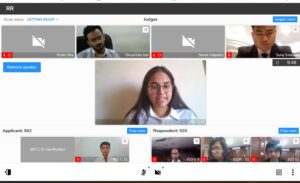
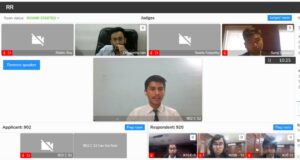
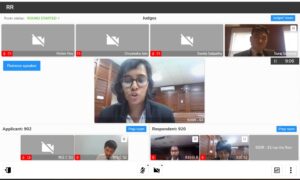
VCR-1: 927 vs 910
13:23: The Courtroom is set, and the teams are ready. The Preliminary Round has begun in full swing in the courtroom, with an unbridled enthusiasm!
13:24: The first Counsel begin with her submissions. She provides a succinct and concise outline of the structure of her arguments.
13:26: The counsel is putting forth her grounds by keeping the attention of judges on specific clauses cited by her.
13:28: As the Counsel is moving ahead with her submissions, she retains a balanced bearing on the factual context of the present case. She seems to be well versed with each and every fact involved in the proposition.
13:29: The counsel moves to her second submission with no incoming questions from the panel. It seems that the judges are having no queries in response to the case presented by the counsel.
13:31: After almost 11 minutes of submissions, finally the counsel received a question from the panel which she countered in an elegant manner and the counsel was able to satisfy the judges with her submission.
13:33: Rather than limiting her submissions to either factual context or legal context, it can be observed that the counsel is following a balanced and prepared approach by taking both the contexts in a graceful way.
13:35: With no queries from the panel, the counsel successfully submitted her grounds. The floor is now open for the second speaker to take the podium.
13:36: Second Counsel starts with the fourth issue.
13:38: With uninterrupted presentation from the second Counsel, the courtroom is maintaining a positive atmosphere. Though with no questions from the panel, it may seem that there are slightly less productive discussions taking place.
13:41: While both the counsels are well versed with what they intend to present, it can be concluded from the external view that the first counsel was more certain and composed in her approach.
13:44: There seems to be a similarity and extensive background work from submissions of both the Counsels as both of them are following the same approach in their submissions, i.e., citing legal precedents and attaching it to the facts of the present case.
13:45: Judges still pose no queries. Counsel is maintaining his hold over his submissions and constantly keeping check with the satisfaction of the judges.
13:47: The second Counsel completed his submission by presenting claimant’s prayer before the allotted time.
13:48: The first counsel of respondents proceeded with his submissions after laying down the structure which he will be following in his presentation.
13:50: There arises no queries from the part of panel. Counsel is presenting his submissions relentlessly.
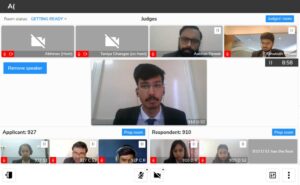
13:54: In the Courtroom, the atmosphere is becoming more and more monotonous. An energetic response is in utmost need from the panel.
14:00: Finally a question came from the panel regarding the intention of the parties in the present case. The second Counsel answered the query in a positive note.
14:01: The first counsel asked for an extra 30 seconds to complete his second argument.
14:02: The first counsel completes his presentation. Judges, who are as cool as before, gives the permission to the respondents’ second counsel to take the floor.
14:05: The second counsel retains the attention of the panel on her submissions by referring to particular sections and facts of the case.
14:09: The counsel is proceeding with her submissions in a graceful manner, while at the same time asking for satisfaction of the panel time to time.
14:13: The judge asked the 2nd counsel to expand her argument over the intention aspect in her submissions.
14:14: One of the judges directly questioned the liability behind the actions which respondents are trying to protect.
14:16: The counsel answered the query which was met with a satisfactory response from the panel and thereafter proceeded with the 4th submission.
14:17: Counsel asked for an extension of time of 2 minutes to complete her submission.
14:18: It is to be noted that while the claimants completed their submission before the completion of their time limit, both the counsels of respondents have asked for extra time.
14:20: Time’s up but prayer is still left. The counsel proceeded to complete her prayer. Time management could be the effective tool in deterring the position or marking scheme of both the parties in the present case.
14:21: Following the extensive deliberations on part of all the counsels, we will proceed to the rebuttal and sur-rebuttal stage.
14:22: Claimants put forward their rebuttals in less than 1 min. It seems either they are fast in putting across their submission or they have failed to find loopholes in the respondents’ case.
14:25: Rounds have been completed successfully. Judges have gathered in the judges room to discuss the marking scheme and feedback that will be provided to both teams.
VCR-2: 902 vs 921
13:35: The war bell has rung and the fierce oral rounds for session 4 has started. The first counsel is enthusiastically proceeding with his arguments. The absence of research on the applicants’ side does not seem to have brought down their spirit in any way.
13:38: The counsel has taken pace and is confidently proceeding with submissions on basis of the IAA. The counsel is aggressively arguing on the mandatory clause of the agreement.
13:42: The arguments have taken a turn where the counsel can be seen resorting to their own memo and citing parts of the Hague Visby Rules too. The Counsel has an air of confidence engulfing him which is enabling him to present his arguments smoothly and structurally.
13:45: The internet connection issues are severe and haven’t spared the judges either! It may be difficult to judge the Counsel given the constant disruptions but hopefully the scenario will change in some time.
13:47: One of the judges in this particular Court room is engaging with the Counsel at some points seeking clarification on arguments and posing relevant questions too. The Counsel, in every way tried to, frame answers for the same but abruptly got disconnected.
13:50: The Counsel has returned in full swing and is knocking away the questions spun at him proceeding to the final limb of his argument. The Counsel is seen emphasizing on the liability of the defendants claiming an exorbitant sum in the form of damages. It seems like the judges were satisfied with the submission before them since they refrained from asking any questions further.
13:55: The second counsel of the applicants has taken the floor. She looks equally confident and has started with her arguments blazingly. She has, however, been stopped by one of the judges with a genuine and brief question which has been excellently answered by the counsel citing a prominent case law.
14:00: The counsel is seen carefully building up on her arguments using concepts of bailment and sub-bailment. She has strided onto her final submission regarding the due diligence and breach of duty on part of the defendants justifying the claim made by the applicants.
14:05: The Counsel can be seen emphasizing on modern technology wielded in weather radars but this limb of the argument is objected by one of the judges who intends to question the accuracy of technology altogether.
14:08: After the Counsel has presented her submissions, she is countered with a question on the Himalayan clause which has been beautifully cleared by the Counsel with a soothing smile.
14:11: The baton has passed on to the Respondent side but the first counsel has encountered severe connectivity issues and the respondent side has proposed a unique solution of starting off with the submissions of the second counsel.
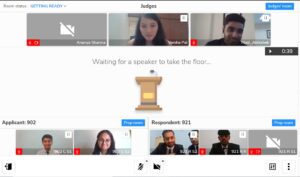
14:15: The second counsel is thus seen aggressively defending his party but there are certain gap areas identified by one of the judges who is politely asking for more more clarification on the same.
14:17: The initial arguments entail the nitty-gritties of the limitation of liability along with the intricacies of the bill of lading in question. With 5 minutes left in hand, the Counsel is being fired with questions from the judges.
14:21: The Counsel is seen quoting and elaborating on the various rules and provisions used in their memorial in an attempt to substantiate the Respondents’ side.
14:24: Finally after resenting the last two arguments, the mic has been passed on to the first Counsel who has finally been able to get hold of a stable connection. He looks a little nervous due to the rocky start and is advocating for the appointment of a sole arbitrator.
14:28: It seems like the Counsel has still not got hold of a stable internet connection because the persistent disruptions have made it difficult for judges and the other participants to comprehend his submissions. Despite the minor consistencies, the show is going on.
14:30: The Counsel has been thrown off-track by one of the judges who has posed a query which doesn’t seem to have been answered with conviction. Nonetheless, the judge has been kind enough to let the Counsel proceed with his other arguments.
14:33: The network glitches seem impossible to be tackled on the part of the first counsel who has been struggling to submit his arguments from the very beginning of the rounds. There has been a turn of events where the first speaker has given up on his network and resorted to his co-counsel for aid. The second counsel has thus lent his device to his co-counsel.
14:38: The first counsel is now pacing with his arguments and his voice can finally be heard with clarity and lesser impediments. The counsel ended his submissions with a sincere apology for the inevitable virtual world issues.
13:43: The rebuttal rounds have commenced and the first counsel from the applicant side is seen vehemently refuting certain parts of the arguments used by the defendants. The defendants have successfully catered to the questions put forth by the applicant side in the sur-rebuttal round.
13:48: With an end to this wonderfully quirky and consistently inconsistent round, the judges have been sent to their respective rooms to deliberate upon the scoresheet and performance of the participants, we hope that the internet connection is kind to the participants in the following rounds!
VCR-3: 915 vs 925
13:43: Due to connectivity issues from the judges’ side, there was a delay in the initiation of oral rounds.
13:44: The first counsel from the claimants’ side begins with their submissions regarding issues 1 and 2 respectively.
13:46: The arbitrator asks the counsel to furnish more clarification regarding the application of judgements in this particular case.
13:38: Even after incessant questioning by the judges, the counsel proceeds with great confidence makes seemingly satisfactory arguments
13:51: The counsel submits that the SCMA rules will precede and there should be 3 arbitrators appointed, the counsel goes on to explain in great detail and substantiate their arguments suing several case laws.
13:55: The arbitrator again attempts to baffle the counsel with an intensely long question but the counsel seems unfazed and gives a satisfactory response.
13:59: The counsel proceeds to establish their last limb of the submissions stating that, the Hague Rules supersede any other rule as it has force of law in the present contract.
14:02: The second counsel begins with their submissions regarding issue numbers 3 and 4 respectively regarding the liability of the respondents and the amount of damages the claimants are entitled to.
14:05: The judge asks the counsel to furnish any fact findings regarding how exactly the loss occurred and in what specific circumstances. Also, the judge asked the counsels about the exact meaning of ‘seaworthiness’.
14:06: The counsel attempts to respond to the judge’s two-fold question and draws their attention towards the case study but unfortunately the counsel is not able to give a satisfactory answer.
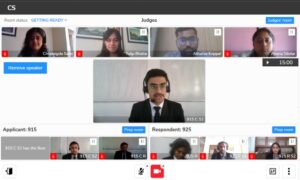
14:12: The counsel proceeds to submit that Respondent 2 is liable due to lack of due diligence and cruise is rendered unseaworthy which was the duty of the respondent.
14:16: The judge asks the counsel to apply the Hague Rules in the current case and establish a direct connection between the bill of lading and the loss occurred.
14:19: The counsel receives an extension of 2 minutes to summarise their submissions.
14:21: The first counsel for the respondent side begins with their submissions regarding the first issue and a sub issue of the second issue.
14:26: The counsel disagrees with the judge’s contention regarding what law will govern the arbitration and submits that the institutional laws will not override the International Arbitration Act of Singapore.
14:30: The judge asks the counsel that why would the party autonomy be overridden? They also asked to justify how the International Arbitration Act will have precedence over SCMA rules?
14:36: The counsel receives an extension of 2 minutes to summarise their submissions.
14:39: The second counsel for respondents’ side begins with their submissions regarding the remaining issues.
14:42: The counsel continues to establish the overriding effect that the Hague rules will have over SCMA rules.
14:46: The judge again interjects to ask the counsel to establish how in the current case the applicability of Hague Rules will take place in order to decide the liability
14:50: The counsel seems utterly baffled by the question asked by the judge but smartly attempts to evade it by moving on with their submissions.
14:53: The judge directs the counsel to clarify the position regarding who is the carrier and the consignee to further establish the liability of the respondents. In response, the counsel seemingly gives an unsatisfactory answer.
14:56: The counsel makes the last limb of their submissions by submitting that the Himalaya clauses can be considered valid exemptions with regards to establishing liability
15:00: The counsel concludes their submissions by submitting the final arguments regarding the damages to be decided in the current case
15:04: The counsel for the claimants conclude their case by submitting their rebuttals.
VCR-4: 920 vs 911
13:31: The round has started. The first speaker from team code 920 has taken the floor.
13:33: The speaker has confidently taken charge of the courtroom. Maybe, they are very assured about their chances in this round.
13:36: The Bench has taken to questioning as well. Till now, the speaker has been handling those questions with perfect composure.
13:40: The Speaker braved through the network glitches she was facing and continued with her submission in full force!
13:41: The Bench directed a “Where is the seat of arbitration, Counsel?” at the Speaker and a follow up question after that, which the Speaker breezed through!
13:43: Good going! The Speaker continues keeping the Bench and the Court captivated with her crisp submissions!
13:45: The Speaker has concluded her submissions and the floor now belongs to the second speaker.
13:48: The Speaker has a slight tremor in her voice while answering the question directed by the Bench at her, but she has been putting up a very brave face and keeping it under control!
13:50: “Why are you so adamant that it serves the Claimants better if the Hague Visby Rules apply instead of the Hague Rules?” The Bench asked the Speaker, which the Speaker started to address, only to become prey to yet another connected question from the Bench!
13:53: After a certain point raised by the Speaker, the Bench continued to go just as hard on her by directing a “We suggest you abandon that line of argument, Counsel.” However, the Speaker, this time, had a case law up her sleeve to substantiate her argument with!
14:00: The Speaker is rapidly running out of time! Will she have enough time to complete her submissions to the best of her abilities?
14:02: Less than a minute left for the Speaker to finish her submissions and the desperation on her face is showing! But she still manages to articulate her thoughts and arguments perfectly!
14:08: It has been several minutes since the time was up for the Speaker, but her arguments managed to enthrall the Bench enough for them to take no notice of it. The judges allow her to continue with her speech.
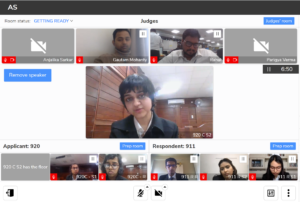
14:10: 911 S1 has now taken the floor.
14:14: “Counsel, I will stop you right here and ask you a very simple question. What according to you is the procedural law for arbitration?” the Bench has directed this brain stormer at the Speaker, which turned out to be a trick question and looks like the Speaker walked right into that one!
14:26: Looks like this Speaker also has a lot to submit! Several minutes since her time was up and the Bench continues to listen to her without interrupting!
14:28: The second speaker has now taken the floor representing team code 911.
14:30: The Bench has a lot of questions for this speaker it seems, answers to which need to be substantiated and corroborated upon with the written submissions!
14:37: The Speaker continues with her submissions, not deterred by the plethora of questions coming her way!
14:45: The Speaker is finally done with her submissions, and now it is time for the rebuttals.
14:46: Team code 920 is back with a slew of rebuttals!
14:50: Team code 920 is done with their rebuttals and boy, there were so many of them! Enough for the Team to actually ask for an extension of 10 seconds!
14:51: Team code 911 is now slicing through the rebuttals of Team code 920!
14:52: After an epic fight in the rebuttals round, we conclude session 4 in VCR-4. Stay tuned for more sessions and more mooting!
VCR-5: 923 vs 916
13:40: The counsel for claimant starts off the first preliminary round for the day here in VCR-4 by making their submissions on the composition of the Arbitral Tribunal.
13:45: In a tense atmosphere, the counsel makes submissions of the implicit agreement between the parties on the application of the SCMA Rules.
13:49: Submissions regarding the unseaworthiness of the vessel supplied by the respondents are made by the counsel. Further, the applicability of the Hague Rules is discussed by the counsel.
13:55: Yielding the floor to their co-counsel, the first counsel for the claimant escapes from rigorous questioning.
14:00: The counsel makes comprehensive submissions on the duty of care that flows from the contract and the liability of the carrier.
14:06: The bench questions the counsel on the tests of negligence and asks for authorities on the same.
14:10: With an extension of time, the counsel races to the finish mark, concluding with their submissions on causation and liability.
14:14: The counsel for respondent begins confidently and explains the facts for the panel.
14:17: Submissions regarding the application of the International Arbitration Act and the liability clause are made.
14:22: The applicability of Hague Rules is submitted to be only valid from tackle-to-tackle period. Further, the counsel submits that reasonable endavours were made to prevent damage.
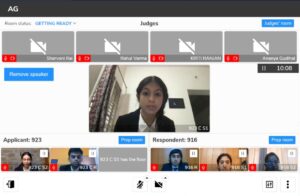
14:26: The bench aggressively questions the counsel on the duty of care of the respondents and the failure to perform the same. However, the counsel does not crack under pressure and continues to answer calmly.
14:29: The counsel addresses the bench’s questions on the applicability of the Himalaya clause and the unseaworthiness of the vessel.
14:32: The co-counsel now takes the floor and makes their submissions regarding the conflict of laws, contractual intention of applicability and the liability of Tawe and Cruze.
14:39: After some technical issues, the counsel resumes their submissions on how the bill of lading saves the respondents from liability.
14:49: The counsel makes their submissions on the non-applicability of the Hague Rules.
14:50: Trying their best to battle technical glitches and the intensity of the questioning, the counsel races towards the end of submissions on the side of the respondent.
14:54: The claimants’ rebuttals contribute further to the tense atmosphere in the room.
14:54: The respondents do not back down from a fight and submit an equally fiery rebuttal, concluding an extremely intense round.
VCR-6: 926 vs 904
13:36: The rounds have commenced! It’s a new day and every is here with renewed zeal and vigor to win this. May luck be in their favour and may the best team come out as the winner!
13:38: The first counsel gracefully answers the question regarding the ‘clause paramount’ and was apparently able to satisfy the judges with the answer.
13:41: Confident and poised, she puts her point across and deals with tricky questions skillfully. So far, so good!
13:44: Oops! Looks like the counsel is being grilled by both the judges regarding the application of the SCMA rules. While this can seem intimidating to most, the speaker seems to have no problem answering their questions. Her confidence is unwavering.
13:47: The speaker continues, her team members nodding in unison. The judges ask her to provide some precedents. The counsel answers in affirmative but doesn’t specify what the precedents are. After some probing by the judges, she very vaguely directs them to her compendium. All this while, the team have been losing precious time.
13:51: The clock is ticking and looks like the counsel is rushing to finish her arguments in whatever little time she is left with.
13:52: Jurisdictional Importance! “But we are not in UK, so why should be follow this?” The judges are intrigued to know why the counsel is basing her arguments on just the presuasive value of UK law, as the counsel contends.
13:53: The counsel is quizzed regarding the facts of the case. Turns out, she’s very well-versed in them and has no problem coming up with the right answers!
13:55: “Show me another rule or something else, this is not applicable!” The counsel seems flustered after the judge’s remarks but she quickly gains composure and answers the question. But looks like her answers aren’t good enough and the judges do not seem very happy about it.
13:58: The second speaker begins and the judges have started their line of questioning already.
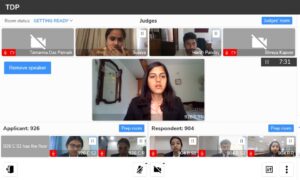
14:01: The grilling has begun! The counsel however seems very unfazed by it. Her overall demeanour is very calm and poised which must’ve sure helped her score brownie points.
14:05: The rounds seem to be progressing smoothly, with minimal questioning.
14:13: “So you agree that you have failed to provide them with all the details when you didn’t tell them to the value of the goods?” The counsel agrees, albeit reluctantly. The counsel pleads on the basis of morality and contends that they should be concerned about the people on the vessel. “How can they send a vessel to the seas that is not seaworthy? Think of the people!” The counsel seems enraged.
14:09: “I am sorry, but is this an appropriate forum to deal with torts?”, ask the judges. The counsel answers that even if not with tort, the claimant would like to go ahead with bailment. When asked to provide a precedent, the counsel denies by stating that she has two more issues to cover. Turns out, this isn’t a smart move. After some more questions, she decides to abandon this argument. The judges do not seem very impressed by this.
14:14: Seems like the counsel can already predict what the respondents will argue and tries to provide satisfactory counters during her pleadings.
14:18: The judges do not look very happy. “You haven’t satisfied us with respect to our jurisdiction, so I don’t understand how you are proceeding?” The researchers come to the rescue and save the day by providing an answer for the same.
14:21: Uh-oh! The counsel is flustered, the judges are not impressed and she has already exceeded her time limit by a huge margin. The counsel tries to pacify it by ensuring the judges that she will read about every answer that she has been unable to give during the rebuttal rounds. What good will that do, one might wonder.
14:25: From the looks of it, time is an illusion for the counsel and she proceeds with her submissions, even after exceeding her time limit by a huge margin.
14:28: “You should have reminded us and asked us for extensions!” The judges are enraged and ask her to wrap it up quickly.
14:30: “Not at all satisfactory.” The flustered counsel quickly summarises her arguments and steps down after what seems like an eternity.
14:33: The judges are baffled! “You say its an honour to argue before the Tribunal but your co-counsel says in the chat that it is a gross miscarriage of justice!”
The drama just keeps flowing in when the respondent team makes a desperate attempt to convey their agony to the judges. The judges look very amused because of such behaviour. #nluoimam
— NLUO International Maritime Arbitration Moot(IMAM) (@NLUO_IMAM) March 25, 2022
14:37: The virtual courtroom is in chaos! When unable to answer the question, muffled whispers which eventually proceeded to become loud screams could be heard from the speaker’s background.
14:44: The counsel suddenly becomes quiet and tries peeking at previously prepared material by her team when she’s unable to answer the judges.
14:47: The counsel is shivering, she goes completely still when the judges grill her. There’s complete silence and her other team members are in distress.
14:50: She accepts defeat! “Madam arbitrator, I do not have an answer for that. I apologise.”
14:51: Apparently exceeding time limits is the defining feature of the teams in this courtroom. The respondent’s first counsel also has exceeded her time limit by a considerable amount.
14:53: After a lot of shaky remarks like “I am not sure Mister arbitrator” and “I don’t know”, the counsel tries to explain how all sorts of hurricanes are natural disasters. The judges think otherwise.
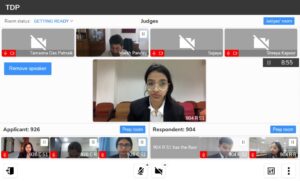
14:54: The second counsel steps in. Let’s watch if he can undo the damage and redeem the rounds for the team
14:57: So far, so good! The counsel argues confidently and everyone in the courtroom listens in awe.
15:02: The round is progressing smoothly with minimal questioning.
15:06: The judges seem impressed by the counsel and do not question him regarding his arguments.
15:08: Trouble has started brewing for the counsel! His arguments lack proper legal reasoning and the judges grill him regarding the loopholes in the arguments.
15:13: Following suit, the counsel has been speaking for more time than what was originally allotted to him.
15:19: The counsel concludes with the prayer.
15:20: Speaker for the claimant begins with her rebuttals. She has kept her promise – she indeed has come prepared with answers that she was previously unable to answer during her submissions.
VCR-6 Counsel: “It’s just like taking a helmet with you when you ride your bike. When you take the ship to the sea, you must take the weather radar along for your own safety.” #nluoimam
— NLUO International Maritime Arbitration Moot(IMAM) (@NLUO_IMAM) March 25, 2022
15:26: The counsel is one of the lucky few who get extensions during the rebuttals also. But just like last time, she goes on and on. The judges however, do not seem to mind that and are intrigued to listen to her arguments.
15:29: There is a total disregard of time limits in this courtroom. The counsel for the respondent finishes with his sur-rebuttals. But the judges need more clarity and have more questions for him.
15:32: The teams have joined the prep rooms and the judges deliberate among themselves.
15:39: We are beginning with the feedback for the participants. For the readers, we will resume our live-blogging in session 5 which starts from 5:30 pm. We are so excited for the last preliminary round i.e. Session 5 before we start with the knockout rounds tomorrow!
VCR-7: 918 vs 919
13:31: The new day begins with energized teams making their submissions with full confidence.
13:33: The applicant is asked not to deal with the submissions regarding the number of arbitrators since the respondent has already agreed to have Singapore as the seat of arbitration.
13:35: The counsel proceeds with her further submissions stating that SCMA rules will govern the proceedings today.
13:38: The next point raised by the applicant is that the panel shall consist of three members instead of one.
13:39: The Tribunal is perplexed regarding the application of International Arbitration Act since the seat is already decided to be Singapore. Moreover, the counsel is also asked to justify the same with the help of a test as proposed by law.
13:40: The counsel handles the question well and is able to convince the Tribunal with her explanation
13:45: While a slight technical glitch halted the proceedings in the courtroom, it has now resumed in full swing.
13:46: The submissions continue with the counsel’s argument regarding the damages caused by the defendant and the counsel lays reliance on the Hague Visby Rules and Bill of Lading
13:47: The Tribunal questions on the basis of the addendum which provides for discharge of liability (which ends when goods leave Odyssefs)
13:50: A long series of questions follows on the arguments put forth in this regard, and the authorities being cited by the counsel are also heavily questioned. The counsel dodges the questions, however the judges do not appear to be convinced with her line of reasoning.
13:52: With a little skepticism on the part of the judges for the submissions of the first counsel, it is now time to judge the second speaker. Time will tell if the second speaker is able to turn the tables!
13:54: The second counsel begins by addressing the issue of liability. She makes her primary submission confidently.
13:57: The judges cite their difficulty in understanding the submissions being made in the regard of Hague Rules being applicable vide a contract, and how the defendants cannot use the Bill of Lading for their defence.
13:59: The counsel puts forth the justification for the same in terms of the relationship of bailment which exists. However, the judges do not appear to be convinced.
14:00: “There exists a legal impediment” the judges exclaim! The Tribunal continues to pose questions to the counsel and express their hesitance to uphold the arguments being made by the counsel.
14:03: After a nail-biting series of questions, the counsel finally proceeds to her last submission regarding the damages that the applicant is entitled to.
14:04: The counsel heavily relies on judgements of the past from different courts and authorities to establish that the sum of 6 million dollars as damages is justified, and must be paid by the defendants at the earliest.
14:05: The counsel manages her time well, and is able to complete her submissions and further her prayer to the Tribunal.
14:10: The respondent begins with his submissions by stating that the parties have not agreed to multi-member arbitration, and hence only a sole arbitrator must preside over the proceedings.
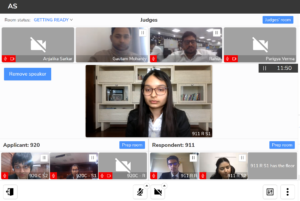
14:13: “It is a solvable problem” as stated by the Tribunal. From the same judgment that the counsel pointed to previously, the Tribunal cites a few lines which highlights the issue they have with the arguments being made.
14:15: An interesting situation develops in the courtroom, and it is with finesse that the counsel tries to tackle the rapid questioning. He continues to maintain his stance, and justify the same.
14:17: The Tribunal continues with their questions on the issue. The counsel handles them beautifully.
14:19: The counsel finally proceeds to the next submission regarding the question of liability.
14:20: The counsel begins by reiterating the same concern that the Tribunal had raised when the claimant was making their submissions in this regard. Relevant cases are also cited to strengthen their stance.
14:21: “What is your position on Article 3 Rule 8 of the Hague Rules?” asks the Tribunal. The same guides the counsel to move to his next submission which very well addresses the concern of the Tribunal
14:24: The counsel yields the floor to the second speaker who takes over to address the issues of liability and damages payable thereafter.
14:28: The counsel sails smoothly through his submissions. Just when it looked like the Tribunal is convinced, the judge questions the counsel stating that he was unable to comprehend his submissions and his party’s stance on the issue
14:29: The counsel quickly caters to the issues of the Tribunal and proceeds to the issue of damages and its quantum.
14:30: To establish their case, the respondent outlines the factual background to enable the Tribunal to appreciate the facts in light of which the defendants submit their arguments.
14:32: “Greater weight is to be attached to the contractual obligations.” submits the counsel. He states that the contract between the parties must prevail over the Hague Rules.
14:33: The counsel now proceeds to his prayer.
14:34: Before the round ends, the counsel encounters one last question from the Tribunal regarding the gold value. The counsel clarifies that the clause paramount in the addendum clearly states that the stance taken by the respondent is justified.
13:37: With a little less than one minute remaining on the clock, the respondents step down.
13:38: The applicant makes few befitting points as rebuttals on the submissions made by the respondent.
13:39: The respondent now states their points of sur-rebuttals. He keeps it short and to-the-point.
13:40: The rounds concluded successfully, with both the teams having put forth their points meticulously.
VCR-8: 913 vs 909
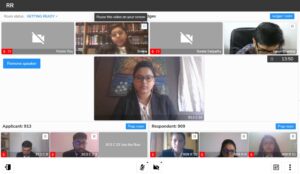
Greetings!
The preliminary rounds continue on Day-2 with Session-4. For live updates follow us on SCC online blog.https://t.co/sIRzhpIgFE#nluoimam pic.twitter.com/dvsGYhikQ0
— NLUO International Maritime Arbitration Moot(IMAM) (@NLUO_IMAM) March 25, 2022
VCR-1: 905 vs 926
VCR-2: 922 vs 915
VCR-3: 924 vs 927
VCR-4: 906 vs 902
VCR-5: 925 vs 918
VCR-5: The bench remarks that the claimants are being very altruistic by claiming only the market price of $600,000 and not the higher amount!#nluoimam
— NLUO International Maritime Arbitration Moot(IMAM) (@NLUO_IMAM) March 25, 2022
VCR-6: 910 vs 913
VCR-7: 921 vs 920
VCR-8: 904 vs 923
Greetings!
After an exhilarating two days, Preliminary Rounds are finally over! Stay tuned to find out the teams advancing to the Quarter Finals.#nluoimam pic.twitter.com/sxeJRK0S9D
— NLUO International Maritime Arbitration Moot(IMAM) (@NLUO_IMAM) March 25, 2022
RESULTS OF PRELIMINARY ROUNDS
Finally, the wait is over and The Moot Society, NLUO is going live on YouTube for the announcement of the quarter finalists for the 9th IMAM! Do check out the video below!
Greetings!
We are pleased to share with you the teams advancing to the Quarter Finals! Congratulations to all the participants.#nluoimam pic.twitter.com/5cUsfZ8iFO
— NLUO International Maritime Arbitration Moot(IMAM) (@NLUO_IMAM) March 25, 2022
We heartily congratulate all the teams and wish them all the best for the Quarterfinals. These teams will give a cut-throat competition to secure a spot in Semi-Finals.
QUARTER FINALS-1
VCR-1: 926 vs 905
15:05: The quarterfinal round has begun here in VCR-1 and the first speaker of Team 926 has already taken the courtroom by a storm with utmost confidence and clarity showcased by them!
15:08: After briefly explaining the facts, the Counsel now proceeds to her submissions. But the judges already have a question for her. This round is already going at a rate of knots.
15:09: Requesting the judges to refer to Rule 2 of the SCMA Rules, the Counsel puts forth her argument.
15:11: “Are the SCMA Rules attached to your compendium, Counsel?” asks Mr. Choudhary. When the question was met with a negative response, Mr. Choudhary smiled and said, “Then where are the judges supposed to refer to, Counsel, if it is not even attached to your Compendium?”
15:14: However, once that was sorted out, with the Counsel reading out the Rule to the members of the Bench. Looks like Ms. Thiruchelvam has another question already ready for her!
15:17: Continuing with her arguments with flair and confidence, the Counsel does not face even a moment of hesitation and anxiety, despite the clarifications and questions being directed at her!
15:20: A few minutes have passed and the Counsel is still going strong. There does, however, seem to be a drop in the number of questions in the Courtroom. Maybe the Counsel’s confidence is infectious!
15:22: Now there seems to be an internet issue the Counsel is facing.
15:23: Oh, she is back! But wait, Ms. Thiruchelvam already has a question for her, the moment she is taking up where she left off!
15:24: The Counsel, without batting an eyelid, explained to the Judge that the answer to her question comes up in her next argument, and hence continues with her submission.
15:25: The Speaker has been able to answer the question to the satisfaction of the Judge. But Mr. Choudhary now wants her to provide argumentation of the members of the Panel with case law to substantiate her arguments.
15:26: The case law question looked like a stumbling block for the Counsel. But it looks like she has taken control of the situation once again, even before we could be properly certain that she was anxious!
15:28: The Counsel has finally completed her submissions and is now answering one final question posed by Ms. Thiruchelvam, only to be directed another question at by Mr. Choudhary. That too, the Counsel answered with the perfect poise she has been mantaining throughout her submissions!
15:30:Go Teamwork! We now have the second speaker from Team code 926 who has taken the floor, taking up from where her Co-Counsel left off, seamlessly blending her submissions with the former Speaker! Now that is teamwork!
15:33: The Counsel is also citing case laws to substantiate her arguments! Looks like the Counsel will absolutely make up for the lacunae in her Co-Counsel’s submissions!
15:34: Counsel is now providing the Courtroom with an analogy to build on her stand, which indeed seems to be a great point to bring up!
15:35: The Judges have not posed even a single question to the Counsel yet. In fact, the Counsel herself asked the members of the Bench if there were any questions or clarifications to be sought, but incredibly, there wasn’t even a single question from any of the three judges!
15:41: Has the Counsel rendered the Judges completely speechless with her arguments? Unbelievable, but true, the Judges still don’t have a question for her! Wow, she seems to be doing a splendid job!
15:41: Finally, the Judges have a question! But wait- no! It’s not a question really, it is a mistake in a number that the Counsel mentioned, and Mr. Choudhary rectified that mistake that elicited a smile from the three Judges and the Speaker herself as well!
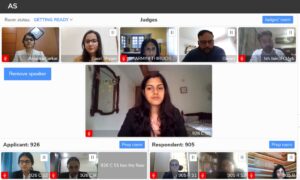
15:46: Looks like Mr. Choudhary’s clarification lifted the stopper in the line of questions from the Bench! Mr. Choudhary, after his clarification, directed an actual question at her, which once the Speaker answered with her self-assured smile, was quickly followed up with a question from Ms. Thiruchelvam.
15:50: The Counsel seems to have finished with her submissions, and is reserving the rest of her time for rebuttals and has directly moved onto her prayer. This was one very enthralling team!
15:51: Speaker 1 from the respondents’ side (Team 905) now has the floor to herself now. Let’s see if they can match the claimants!
15:54: The Counsel, after quite a few minutes of speaking, now has the first question to respond to! Mr. Choudhary is asking questions that somehow seem to befuddle the Speakers (all of the speakers till now) for a few seconds before they can get a hold of the situation!
15:57: Soon after the round of questioning by Mr. Choudhary, Ms. Thiruchelvam hurls a clarification based question towards the Counsel, which she is able to answer seemingly to the satisfaction of the Judge!
16:02: “Counsel, is Clause 2 a typed clause or an addendum clause?” asks Mr. Choudhary, which the Counsel attempts to answer but then she is directed to another series of questions by the Judge.
16:05: The Counsel again has the Courtroom under her control, having answered the questions of Mr. Choudhary (whether to his satisfaction or not is a separate issue). She then proceeds to the rest of her submissions, without squandering away any of those precious seconds ticking!
16:08: “Counsel I don’t think that’s the English Law position per se…” points out a skeptical Mr. Choudhary, much to the distress of the Counsel!
16:10: The Speaker is not waiting around being distressed, however! She is vehemently trying to defend her stand in front of the panel of Judges, which Mr. Choudhary acknowledged with a lighthearted laugh! Looks like her efforts were not all in vain!
16:13: “How old is the case law you are referring to?”, asks a bemused Mr. Choudhary to the Counsel. On receiving a ‘1935’ in response, Mr Choudhary asks, “Do you think that is the current position of the English Law, Counsel?”
16:14: Mr. Choudhary seems to be giving the Counsel quite a hard time with his plethora of mind bogglers! “Claimants, I would give you 30 seconds to counter that. Do you agree with the Respondents or not?” he asked the other team! The Speaker is looking genuinely harassed at this point!
16:20: Speaker 2 from the respondents’ side (Team code 905) has now taken over, and has immediately got to the crux of her arguments!
16:21: Reiterating her Co-Counsel’s argument, this speaker is determined not to get intimidated by either questions or her own explanations it seems! Admirable!
16:25: The Speaker vehemently and vigorously continues with her submissions, barely exposing even the slightest chink in her armour!
16:26: “I sense a question?” she asks the members of the Bench, and when responded to with a shake of their heads, proceeded to making the rest of her submissions with an air of confidence!
16:29: Requesting the Judges to refer to a certain page of the opponent team’s memorial in order to prove her own point, this Counsel has completely owned the Courtroom!
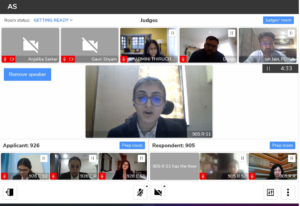
16:31: Looks like this Courtroom has quite a few Speakers today who are rendering the Judges completely speechless! So far, not even a single question has come her way, allowing her to defend her stand without any interruption at all!
16:35: The Speaker continues to emphatically argue in front of the Judges! A little more than 5 more minutes to go for her time limit to end, and she still doesn’t have to deal with a question!
16:36: The Speaker has concluded her arguments before her time was up! Gosh, that was one entire speech without a single question from any of the three Judges!
16:38: We are back with the rebuttals now! The claimants present their three-part rebuttal with ultimate precision and grace!
16:40: The rebuttals are so very well structured that the Speaker is including back-to-back case laws in her rebuttal!
16:42: The Speaker points out that any overriding decision of the Judges today to the 4-Judge Bench decision, would be gross injustice to the claimants today!
16:43: Team 905, in response, requests a quick sur-rebuttal now.
16:45: “When we are talking about the applicability of the Hague Rules, a Singapore High Court decision holds no value! The appropriate law is the English Law!” the Speaker thundered!
16:47: The round has ended, with Team 905 concluding their sur-rebuttals heatedly.
VCR-2:922 vs 902
12:45: Welcome all to the first knockout round of the 9th Bose & Mitra & Co. International Maritime Arbitration Moot! After announcing the breaks yesterday, we look forward to the teams battling it out in the courtroom with the arguments and penchant for mooting. We can’t wait for the participants to raise their contentions and the challenges that the knockout rounds are going to present! It’s an early start for one of the Quarter Final rounds. The round will start at 1 pm and just like the prelims, we will bring you live updates through the round.
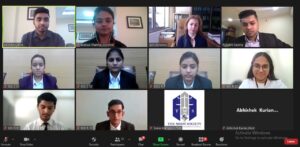
13:10: Aaaaannnnddd we are underway! The Quarter Final rounds have started with cheerful and enthusiastic faces. The judges, Ms. Ann Stylianou and Mr. Rishab Saxena introduced themselves and warmly presented a forum for the parties to proceed with their arguments. A gentle reminder about the structure of the round – The claimants’ side has been allotted a full 45 minutes with the first Counsel being given 22 minutes.
13:12: The first Counsel with an air of calmness and confidence has kickstarted the round and is carefully walking through the framework of her arguments and issues. She is arguing on the precedence of SCMA over International Arbitration Act. None of the judges have stopped her yet for this limb of the argument. She has now proceeded with the citation of a couple of authorities in an attempt to establish a strong case.
13:15: The Counsel has however been stopped midway while presenting her argument. “What is the law governing the contract?”, asked Mr. Saxena. In response, the Counsel affirmatively replied “The English Law governs the contract.” Following up on his question Mr. Saxena asked “So you agree that the procedural law is that of Singapore?” The Counsel replied affirmatively to this question after which the Counsel was allowed to proceed with her next argument.
13:18: Mr. Saxena seems to be fascinated by an argument of the Counsel on lex arbitri and lex specialis seeking more clarification on the rule of mandatory and non-mandatory application. The Counsel looks confident and sounds quite prepared with the framework of her arguments.
13:21: The Counsel has been allowed to proceed to the next contention and she has confidently mentioned the Hague Visby Rules. When she is countered by Mr. Saxena who asked, “Where did you get HVR and how do you use that?” The Counsel has been able to satisfy the curiosity of the judge by pointing out the ambiguity in the factsheet where only Hague Rules were mentioned and no specifics were given. “Interesting”, commented Mr. Saxena and the Counsel was allowed to move on further.
13:24: The Counsel is now vehemently arguing over the liabilty of the defendants on the contract of carriage. Mr. Saxena looks quite involved in the session and is seeking for some reference to the contract entered into by the parties. The Counsel has successfully been able to point out the contract in the factsheet.
13:27: The Counsel referred the judges to their memorial which apparently cleared their confusion regarding Tawe’s status as a carrier. Following this, the Counsel has moved on to the next limb of the argument.
13:28: “Can you link the provisions you just read with the facts of this case because I am unable to follow?”, requested Mr. Saxena. The Counsel is enthusiastically reading up the clause in the agreement on the applicability of HVR in some cases. The Counsel is arguing that this is a general clause to which Mr. Saxena retorted, “But that is where you are wrong because this is a typed clause so how can you say that it is a general cause?” The Counsel, replying to this query, cited a landmark judgment in support of their argument.
13:32: Time’s up! And the second Counsel takes over now. Ms. Ann has promptly reminded the Counsel that he hardly has a minute left so she must wrap up her arguments quickly. The judges have been highly encouraging and involved during the entire round of submissions presented by the first Counsel. The first Counsel has now been dismissed with the second counsel taking center-stage on the remaining issues.
13:35: The second Counsel looks well-prepared and is ready to set the floor on fire with her first set of arguments. She is arguing on the liability and damages claimed. In order to establish her case, she also requests the judges to refer to the claimant’s compendium.
13:37: The Counsel is fiercely arguing that the defendants cannot claim to be a third party in the case as a result of the contract of bailment entered into by the parties. Additionally, the Counsel is seen elucidating on certain relevant case laws which can help the claimants present a strong case.
13:40: The Counsel has not been countered by any of the judges during the course of the presentation of her first issue. She has therefore been allowed to move on to the next issue which is largely based on the quantum of damages.
13:42: The Counsel is now quoting the HVR and striking at the defense argument of the respondents on the liability of their damages claiming that the first defendants are liable for the full amount of converters and they cannot claim any benefit under the limitation of liability.
13:44: It cannot be denied that the Counsel is very clear in terms of the argument she is presenting because of which even the arbitrators are unable to pose questions on her contentions. She is seen emphasizing on the duty of care of the carrier. She is of the opinion that the recklessness of the defendants caused humongous losses to the claimants.
13:46: Mr. Saxena bounces back with a question for the second Counsel for the first time during the course of her speaking time seeking clarification on clause 5. Now Ms. Ann has struck back with a question on how could the hurricane be prevented since it is a natural calamity. The Counsel is aggressively seen pointing out at the fault of the part of the defendants for not repairing their weather radar which could have predicted the hurricane and prevented the entire fiasco.
13:49: Mr. Saxena bounces back with a question for the second Counsel for the first time during the course of her speaking time seeking clarification on clause 5. Now Ms. Ann has struck back with a question on how could the hurricane be prevented since it is a natural calamity. The Counsel is aggressively seen pointing out at the fault of the part of the defendants for not repairing their weather radar which could have predicted the hurricane and prevented the entire fiasco.
13:53: Mr. Saxena seems quite intrigued by the arguments of the claimants and is curious to know if the counsel has any other arguments framed on the issue of bailment which is based on English law or Common law principles. “What are Rotterdam Rules?”, asked Mr. Saxena. This question seems to have shaken the Counsel a little and she has finally pleaded for ignorance. Ms. Ann has pointed out the paucity of time and the claimant has been granted an extension of one minute to present her prayer. The second Counsel of the claimants rests their case and the floor has been taken over by the respondents.
13:57: We begin with the round of arguments for the respondents now! The first Counsel from the respondents’ side is seen steadily moving through his arguments but owing to some technical glitch, the Counsel has been interrupted. Despite some interruptions, the spirit of the Counsel is on ‘Cloud 9’ and he is moving ahead with his set of contentions.
14:01: The Counsel is arguing on the applicability of section 9 of the IAA owing to its mandatory nature. He is now seen quoting section 15(e) of the IAA to establish the application of IAA which allows the appointment of sole-arbitrator in the matter.
14:04: The Counsel is justifying the appointment of a single arbitrator in the matter contending that a single arbitrator can help in expeditious resolution to the matter as compared to an Arbitral Tribunal consisting of 3 members.
14:05: The Counsel is directing the judge towards one of their citations in an attempt to answer the question of the judge on express as well as implied agreement. The Counsel is advocating in favour of Singapore being the seat of arbitration and adds on that lex arbitri shall prevail.
14:11: “The parties have not agreed on the number of arbitrators so does this part does not become completely irrelevant given your submission on sole arbitrator?” The Counsel has however been able to satisfy Mr. Saxena with his answer.
14:13: The Counsel is now striking a comparison between the two Bills of Ladings. Following this, Mr. Saxena shows initiative and asks the Counsel about the facts of a particular case law cited by the Counsel.The Counsel does not seem to have much information on the facts of the case but he is trying in every possible way to atleast put forth the ratio.
14:17: Mr. Saxena then points out that it cannot be denied that there has been negligence on the part of the respondent to which the Counsel replies that they are not denying the liability but they merely intend to limit the liability.
14:19: With a well-framed set of arguments, the first Counsel has concluded his side and the baton has been passed to the second Counsel. The second Counsel is harping on the contractual relationship between the parties.
14:21: The Counsel has used a very unique term “tackle-to-tackle” and she has immediately been interrupted by Mr. Saxena for more explanation on this concept. The Counsel seems well-equipped with the answer for this question and she has successfully catered to the question.
14:23: The Counsel has raised her concern on the point that the respondents’ side were under the impression that the Hague Rules of 1924 would be applicable while the claimants have prepared arguments on a different set of Hague Rules. She has further proceeded to justify the application of Hague Rules 1924 with the aide of various authorities.
14:26: Mr. Saxena has posed a question to the Counsel, “Is there any provision in the Combicon Bill which limits the liability?” The Counsel while replying to this question has cited section 9 of the Combicon Bill which is said to contain such limitation clause.
14:29: The Counsel is defending the respondents’ side refuting the applicability of Hague Rules saying that the tailor-made clauses in the Bill of Lading have to be read in harmony with the Hague Rules if made applicable at all.
14:31: The Counsel’s memorial has a very fascinating case cited which has caught the judge’s attention and they are seeking more details on the same. With these final arguments, the Counsel is closing down on her arguments with her prayer. The respondents’ side has been able to wrap up their arguments well within and they owe it all to their well-structured as well as concise submissions.
14:34: For rebuttal rounds, the claimants are posing questions on the lack of emphasis over the party autonomy by the respondents’ side. More questions pour in on the liability and its limitation as claimed by the Respondent. The Counsel from the Respondent side is coming up with well-defined answers for all the questions fired at them. This round has truly been a treat to the eyes and ears of all. Each side was seen striving to win over the judges with their set of arguments. The arbitrators have been sent to their respective breakout rooms for deliberation. It cannot be denied that declaring a winner here would be a tough call for the judges.
VCR-3: 909 vs 910
15:06: With quite a lot at stake for teams 909 and 910, the quarter-final rounds in VCR-3 have commenced! We wish the teams all the best and we hope that we have a stellar round of mooting ahead of us!
15:07: The first Counsel, poised and graceful begins with an explanation of the facts of the case for the clarity of the judges. The entire courtroom listens intently, the respondents are also eager to know how the claimants represent the facts in their favour.
15:09: Laying the structure of her arguments is the second item on the Counsel’s agenda. A very confident start and the counsel has not faced any tough questioning by the judges. Lucky her!
15:11: In what can be classified as a monologue till now, the counsel proceeds with her submissions, her confidence increasing with every passing minute due to a lack of questioning from the judges.
15:12: The respondents’ team is engrossed in listening, jotting down every single one of the counsel’s contentions that they can provide a counter for. Looks like we are going to have some fun in the rebuttal rounds.
15:14: Looks the questioning has begun! The speaker’s initial confidence has visibly reduced. The initial bout of questioning is regarding the arbitration clause governing the sub-bailment claim.
15:15: “Just a dispute regarding the bills of lading madam! Not any dispute.” The counsel is frantically trying to come up with any legal backing at her disposal to satisfy the judge. But it seems like she is unable to find any.
15:17: “I will not accept this counsel! How are you saying this! This is so simple!” The judges sound extremely displeased by both the answers and the manner in which the Counsel is answering the questions.
15:19: Uh-oh! The counsel falters. Scared and trying to gather her thoughts, she tries to come up with a suitable answer.
15:20: “You want me to just take your word for it? You don’t have any authority?” The counsel has been unable to skillfully handle the tedious questions by the judges. Not happy with her answers, the judges ask her to move on.
VCR-3: Difference between Singapore and India: “Counsel, this is about a Singapore conflict! I don’t care about Indian case laws!” With trouble brewing for the claimant’s side, she is quizzed about whether she knows the difference between Singapore and India.#nluoimam
— NLUO International Maritime Arbitration Moot(IMAM) (@NLUO_IMAM) March 26, 2022
15:23: The judges are prompt with their questioning, quick to test the knowledge of the Counsel. The Counsel’s answers do not seem to be living up to their expectations.
15:26: The first Counsel yields the floor to her second Counsel. The second Counsel takes the floor, her confidence shaken after witnessing the fate of the first counsel. Will she be able to redeem them? One can’t wait to find out!
15:28: Luck has been favouring our second Counsel so far. She has not encountered any questions and she proceeds with her submissions smoothly.
15:29: The momentum that the speaker had established has been broken. The moment that the counsel was dreading is here – Mr. Anuj quizzes her about the combined transport bills of lading. Luckily for her, the counsel seems to already have prepared the answer.
15:31: Mr. Anuj listens to her answer and satisfied, asks her to move on. The Counsel murmurs a ‘Phew!’ under her breath and continues.
15:32: The respondent team’s disagreement with the claimants’ line of reasoning is clearly visible on their faces. The speaker continues with unwavering ease, further strengthened by the judges’ lack of questioning. Looks like it’s her lucky day and the grilling was reserved only for her co-counsel in the beginning!
15:34: With each passing second, the counsel uses every single legal authority in her arsenal in order to make an attempt to gain advantage over the other team. The courtroom witnesses the mention of various case laws and statutes by the claimants to strengthen their case.
15:36: The second Counsel displays extreme legal prowess. Suddenly however, she is faced with another question! The question is very stringent, but so is the reply. The counsel has managed to match the precision of the question and is asked to continue. Good job, counsel!
15:40: The entire courtroom is engrossed in listening to the second Counsel’s submissions. Her spirits have been bolstered by the fact that she has been able to satisfactorily answer every single question that has been thrown at her so far.
15:43: The judges pose a question regarding the Bills of Lading. “Where do you get such propositions of law?” The counsel falters, takes a moment to regain her composure and gather her thoughts and begins answering the question. Before she could finish, the judges steer her towards providing them with authorities.
15:44: The counsel has been excused for just a moment to come up with the specific case law that she bases her argument on. But oops, looks like this case is not binding and just authoritative. All that wasted time and for what? A case law that isn’t even binding, well to be fair we have all made that mistake but not in the Quarter Finals of the NLUO International Maritime Arbitration Moot!
15:46: Her initial confidence decimated by the rigorous line of questioning. The Counsel is visibly struggling to produce answers that will satisfy the judges. Her teammates are holding their breath – will she be able to answer it? Stay tuned in to find out!
15:49: There is a thrilling exchange of questions and answers! The counsel puts forth some very convincing arguments to bolster her case. The judges seem happy with her answers. In what can be truly classified as a spectacular display of her skills, the counsel HAS indeed managed to redeem their team and convince the judges that their legal backing is sound. Well done, counsel!
15:52: Another round of questions has to be dealt by the counsel. Studying her expressions, it can be inferred that these questions prove to be extremely nerve-wracking for her.
15:53: Looks like we said ‘well-done’ too soon. The counsel is visibly shaken, the judges are so taken aback by the absurdity of her answers that they’re laughing and her team’s initial excitement has died down.
15:54: This round is like none other than before! Ms. Damayanti is clearly dissatisfied with the speaker’s submissions – “What is this counsel?”, she asks. The Counsel gulps and proceeds to stammer her way through what can definitely not be regarded as a coherent sentence. 15:56: The speaker now steps down from the floor after it looks like the questions have evidently taken a toll on her. Good thing that she is finished with her arguments.
15:56: The speaker now steps down from the floor after it looks like the questions have evidently taken a toll on her. Good thing that she is finished with her arguments.
15:59: With the speaker proceeding with his arguments, there is an anticipation of the fate that awaits the teams. The entire courtroom sits still, listening with baited breaths.
16:02: This researcher is an excellent teammate! She assists the speaker in every possible manner and it seems like together, they are determined to win these rounds and perhaps have what it takes to go all the way?
16:03: Here come the questions! It is indeed extremely thrilling to see the counsel justify their side. The researcher again aids him in the same and they demonstrate in front of the judges, through combined efforts, how the presence of a single arbitrator shall prevail.
16:06: The questions just keep pouring in and the counsel tries to clarify his stance. But he isn’t paying enough attention to the questions properly! “Listen to the questions that my brother judge is asking”, Ms. Damayanti strictly warns the speaker.
16:08: Role-reversal?! When we said the researcher ‘aided’ the speaker, we meant that the support that she provided initially complemented the speaker’s arguments. However, at this point, her ‘help’ in the chatbox has become so extensive that she has effectively assumed the role of the speaker, just that she’s not actually speaking it but typing it via the chatbox. Tch-tch!
16:10: In spite of the researcher’s fanatical efforts, the counsel is unable to provide adequate answers. Dissatisfied by that, the judges instruct him to move on.
16:12: The claimants look relieved! While it’s not in the best spirits of the essence of mooting, they look happy that they weren’t the only ones who were unable to escape the grilling.
16:14: An abrupt halt! The judges wait for an answer and the counsel fumbles his way through what we can only imagine as a plethora of tabs and documents open in his laptop to fathom an appropriate answer.
16:16: The silence has finally been broken after what seems like ages. The counsel provides an answer, his teammates nod in unison and the judges ask him to continue. Wonder where his researcher went, at the most crucial moment when he actually needed her.
16:17: Mooting is definitely not for the faint-hearted. The first counsel for the respondent steps down, scared and flustered, wondering about the fate of these rounds that await him.
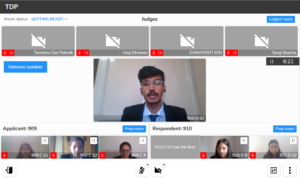
16:19: If we were to describe the second speaker’s demeanour in 3 words, it would be poised, eloquent and confident. Unfazed by the grilling that her teammate underwent just a few minutes ago, the counsel seems sure about their legal arguments and proceeds with them smoothly.
16:21: So far, so good! The rounds are going very smoothly for now.
16:25: We can feel the tension build up when the speaker is asked to answer a question. She goes completely still for a moment. However, she swiftly recovers and goes on with an answer that the judges seem to be content with.
16:28: The speaker displays immensely flawless argumentation and the judges also seem satisfied with her. The claimants do not look very happy about this though, understandably so.
16:30: The counsel and the judges are engaged in an extremely exhilarating round of deliberations over the liability of the carriers. Everyone in the courtroom is in awe of the counsel’s spirited arguments and her determination to win!
16:33: With the competition progressing, the tension in the air is palpable. Ms. Damayanti’s questions forces the counsel to admit that they are at fault for not providing a seaworthy vessel. The counsel’s dejected face bears testimony to the fact that this wasn’t a situation she wanted to experience.
16:37: Like a drowning man clutching at a straw, the counsel makes every desperate attempt to convince the judges of the strength of her arguments. The judges think otherwise.
16:38: The judges don’t seem to be buying it and with every passing second, the counsel is growing more and more nervous.
16:41: With her time exhausted and no satisfactory answers at her disposal, the counsel steps down. Welcome to NLUO IMAM, It’s a cut-throat competition!
16:42: The rebuttals begin! Precise and well-articulated, the claimant’s counsel systematically decimates every single argument of the respondents. To this, we can only wait and watch (or read) how the respondents reply!
16:46: With his eyes on the prize, the sur-rebutals by the respondent’s counsel are equally crisp and clear.
16:49: Pointed questions, efficient answers and teams waiting with bated breaths were the defining features of this round! A truly neck-and-neck competition, may only the best team win!
VCR-4: 906 vs 925
15:15: The quarter-finals in VCR4 start on a note of trepidation with Speaker 1 of claimants’ side listing out clearly the issues faced. The first speaker clarifies calmly to the judges about the parties they represent in the dispute and how the arbitration process would proceed.
15:19: Mr. Pabitra proceeds to ask the first speaker about where their arbitration clause is present in their Bill of Lading and the governing law of their contract. She answers calmly in the face of multiple questions posed by the judges. The teams today are facing quite a thorough bench, it must be said.
15:22: The first speaker proceeds with arguing that only a single arbitrator may be appointed according to the International Arbitration Act which she contends would override the SCMA rules.
15:25: The Counsel argues on the non-mandatory nature of section 9 of the IAA to which Ms. Tripti responds by asking if there is any case law that supports the same. She attempts to justify her stance using interpretation from Indian Jurisprudence. However, the judges insist that they want a precedent set by the Singaporean jurisdiction. Mr. Aziz catches the speaker on her ignorance of the nature of Singaporean Jurisprudence surrounding the non-mandatory nature of section 9.
15:30: Mr. Aziz having practiced in Singapore for years uses his experience to ascertain whether the Counsel is aware of the context behind the amendment of the IAA through the inclusion of section 15. Mr. Aziz attempts to cull out the speaker’s confidence and awareness of the intent behind the legislation and its subsequent developments. Her responses, however, are unsatisfactory and she quickly shifts to her next submission.
15:32: The first speaker argues that the parties only intended to subject themselves to the Hague Rules of 1924 only and this interpretation has been arrived at keeping in with the business sense applied by the parties.The parties have incorporated the Hague Rules through their agreement to subject their relations to UK Common law.
15:34: Time constraints are starting to be more apparent now. She continues to argue that Hague Visby Rules won’t apply since Santos hasn’t rectified its position on the Visby Rules. Mr. Pabitra asks a pertinent question on the applicability of Hague and Hague Visby Rules. Counsel acknowledges that the same would be addressed however, Mr. Pabitra reminds her, “You only have three minutes remaining so use them wisely”.
15:37: Ms, Tripti comments, “Why do you have Clause 2 in your agreement if you only intended to be bound by the Hague Rules?” Counsel calmly answers that Clause 2 must be struck down since it is in complete derogation of Clause 4.
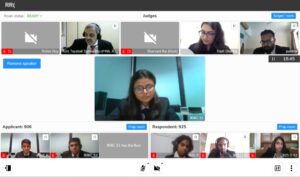
15:39: The first speaker concludes that the Paramount Clause seen in Clause 4 is meant to have an overriding effect on all other clauses of the agreement and thus the carrier can’t limit their liability.
15:40: After a hectic round of submissions by the first counsel, the second speaker follows her brimming with confidence to cover the remaining issues.
15:42: Mr. Pabitra first asks the Counsel about the extent of liability they ascribe to Cruz and Tawe and who would pay the damages. He replies by saying that both are jointly and severally liable and must share the quantum of damages. Mr. Aziz asks whether they are asking for apportioned damages and if they seek damages from both parties or either one. Counsel concedes that they merely need 600,000 dollars however, they are not particular as to who pays them the same.
15:45: The second speaker goes on to clarify the judges’ doubts on how they arrived at the market value especially since it may differ across countries. He relies on a previous case, to show that the value they claim is based on the price at which they bought the cargo, which is what they consider to be the market value for quantifying damages.
15:48: Ms. Tripti seeks a clarification on whether Caspian tried to adopt mitigating measures like taking on an insurance to protect them from loss. However, he tries to avoid the question but Mr. Aziz catches on the speaker’s attempts to circumvent the question. The Counsel proceeds to restate the facts to show that there were no avenues for them to mitigate their losses.
15:50: The counsel proceeds to argue on the importance of providing a seaworthy vessel which forms the carrier’s liability under the Hague Rules. Failure to do due diligence makes the carrier liable in this case.
15:52: While the Counsel argues on quanitfication of damages, Mr. Pabitra asks whether Clause 3 of the addendum would apply accordingly which limits damages to $500 per unit. The Counsel argues that this is in derogation of the Hague Rules which are paramount according to the terms of the contract.
15:55: Mr. Pabitra asks, “The Himalayan clause precludes liability on all third parties so how would Cruz be held liable?” Speaker 2 responds that Himalaya clause provides a blanket immunity which is unconscionable in light of the circumstances and the precedent set in this regard. Judges seemingly satisfied allow the speaker to proceed further with their submissions.
15:58: The second speaker presents a novel argument by arguing that their clients can rely on the Hidalgo Bill of Lading even though they are not parties to the same since it indirectly impacts them. Mr. Aziz asks, “Are there any concepts in contract law regarding the carriage of goods by sea which exist outside of the Bill of Lading?” After three clarifications provided by Mr. Aziz, the Counsel is able to understand the question and satisfactorily answer the same. Seems like the constant badgering by the judges has rattled the Counsel!
16:01: Before the Counsel is able to proceed to the prayers, Ms. Tripti asks for a case law to support their method of quantifying damages at the price they bought the cargo.
16:05: The Counsel is finally able to reach his prayers despite the barrage of questions posed by the judges. The claimants’ case is concluded however, the judges are thorough and are soliciting answers even on the prayers to seek if there is any interest amount claimed. Mr. Pabitra jokingly comments, “So the interest would be $1 a person?”
16:08: The first speaker from the respondents’ side takes the podium. However, the inquisitive bench is undettered from asking a question before submissions even start! Mr. Aziz asks if they can satisfy the Tribunal that there exists no conflict in them representing both Tawe and Cruz at the same time. Ms. Tripti cinches on the Achilles’ heel of Cruz’s position in the dispute in their inability to provide a seaworthy vessel for carriage and asks if Cruz’s admission regarding the same would affect their position in any manner.
16:10: The Counsel, despite the jittery start, proceeds to confidently list out the issues and the respondents’ position on the same.
16:12: The Counsel submits that: In respect of party autonomy in an arbitration, parties’ lack of agreement to delineate number of arbitrators to be appointed and the arbitration seat being Singapore, the parent act of Singapore regarding arbitration must be followed.
16:17: Mr. Aziz contends that since the preamble to the SCMA rules clearly postulates that parties submitting themselves to SCMA must govern themselves accordingly. Why should section 9 be then considered mandatory by the tribunal? The Counsel replies that the nature of section 9 is that it is intended to override the SCMA rules and thus the Tribunal should follow the same.
16:21: Mr .Aziz in a teaching moment clarifies that during the amendment of the SCMA, the Parliament intended to respect the parties’ choices of their own arbitration rules. Thus in respect of those intentions, the respondents must apply the SCMA rules wholly. Speaker clarifies calmly that the conflict between a mandatory and non-mandatory provision, the mandatory provision would prevail. Thus, section 9 providing for the sole-arbitrator to arbitrate the dispute in the interest of preserving costs must be followed.
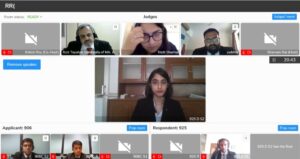
16:27: The Counsel holds his cool amidst the constant questions posed to him by Mr. Aziz and defends his position satisfactorily. However, in the last 2 minutes of the rounds, they rush through their second issue to submit that the Hague Rules don’t have a force of law, they’re merely incorporated and thus the clauses on exemption of liability must prevail.
16:30: The Counsel representing the respondents, starts her submissions by clearly laying out the interests of Tawe and the issues posed. She argues that the terms agreed upon by the parties must prevail over the Hague Rules by citing a case. The judges copiously pore over the participants’ briefs asking for page references at each instance in order to comprehensively understand their case.
16:35: Mr. Aziz upon immediately returning from a technical glitch, proceeds to ask whether the failure to ensure seaworthiness would affect their liability or not. However, the speaker argues that their exemptions are valid and in fact override the Hague Rules.
16:42: The Counsel makes a hypothetical argument to show that even when Hague Rules are applied, the exemptions are valid considering the provisions regarding trans-shipment
16:44: The judges catches out the speaker on the faux pas they made on facts on who is the shipowner and the carrier. The judges direct her to the factsheet to rectify her error. The constant badgering by the bench seems to have unnerved the speaker!
16:48: However, the Counsel jumps back into her submissions and proceeds to argue on how Caspian has waived their right to sue a third party. Further, Cruz as a sub-bailee is entitled to protection under both the original and their own contract. The Himalaya Clause is thus a valid exemption from liability that Cruz can enjoy.
16:53: Mr. Aziz in his characteristic fashion of asking long questions poses another difficult question to the speaker whether there is any precedent that they can provide to support their contentions on an exemption from liability. However, undeterred, the speaker proceeds to provide a case law to support that despite the negligence of the carrier, the exemption from liability clause would protect the carriers even then.
16:57: The Counsel concludes her submissions by stating her prayers. However, the judges proceed to ask questions on prayers as well to leave no stone unturned on what reliefs the parties are actually seeking.
17:02: The claimants present a compelling rebuttal by undermining the case laws presented by the respondents. They proceed to establish the supremacy of the Hague Rules and the responsibility incurred by Cruz under the same is non-derogable.
17:06: Respondents proceed with a convincing sur-rebuttal to establish the fallacies present in the claimants’ case. She systematically lists out the gaps in their arguments and tries to pick at the claimants’ case presented.
17:09: The participants in their advanced round have had to face a tough and thorough bench that asks compelling questions but they prevailed in their knowledge and confidence to satisfactorily argue before the judges. May the best advance to the semi-finals!
QUARTER FINALS CONCLUDE!
RESULTS OF QUARTER FINALS
Finally, the wait is over and The Moot Society, NLUO is going live on YouTube for the announcement of the semi-finalists for the 9th IMAM! Do check out the video below!
Greetings!
After extreme deliberation, we are pleased to share with you the teams that will be advancing to the Semi Finals! Congratulations to all the participants!
In case of any doubts or queries, kindly reach us at imam@nluo.ac.in#nluoimam pic.twitter.com/JGuvQc6tCv
— NLUO International Maritime Arbitration Moot(IMAM) (@NLUO_IMAM) March 26, 2022
We heartily congratulate all the teams and wish them all the best for the Semi-Finals. These teams will give a cut-throat competition to secure a spot in the Finals.
SEMI FINALS-1
R – The School of Excellence in Law, Tamil Nadu Dr. Ambedkar Law University (Team Code 926)
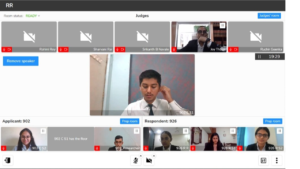
Semi Final-1 Judge: “We don’t arrive so simply at the same conclusion as you do. Just because the parties have agreed to abide by English Common Law, can it be said that the parties have agreed to be bound by the Hague Rules since the same isn’t clear in either Bill of Lading?”
— NLUO International Maritime Arbitration Moot(IMAM) (@NLUO_IMAM) March 27, 2022

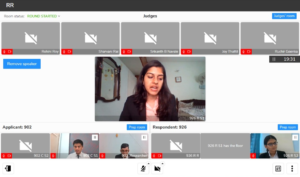
10:14: The Counsel substantiates through a simple example that Cruz can’t be made liable to Caspian since Cruz was never aware of Caspian’s presence.
10:16: As clarified by the counsel, the liability imposed on Cruz is restricted to the contract between Cruz and Tawe. The judges seek some clarifications regarding the proposition. The speaker responds with extreme levels of calmness displayed.
10:19: The Speaker provides a novel argument that Cruz isn’t a carrier as per the first Bill of Lading but merely a third party/ servant. The judges seem to be interested in this argument as they ask for some clarifications and even remark “Good, good” once the speaker is done.
10:24: The Counsel cinches on a weak spot in the claimants’ arguments by emphasising that they cannot pick and choose the clauses they wish to abide by. In the present case, the claimants do exactly that, forgetting that some of the relevant provisions of the Hague Rules stand deleted.
10:29: The Counsel convincingly presents the quantification of damages and how the claimants have excessively quantified the same. She confidently concludes her submissions with the judges seemingly satisfied.
10:32: The claimants take the floor to deliver their rebuttals. They systematically dismantle the cases presented by the respondents in their first issue.
10:34: The claimants conclude their rebuttals by providing sufficient responses to the respondents’ arguments. The judge asks, “What is your response to their argument that due to privity of contract, Cruz wouldn’t be held liable by the claimants.” The speaker and the judge engage in an argumentative conversation. However, the judge seems to be satisfied for the moment.
10:40: The respondents engage in counterfactuals to deconstruct the claimants’ case systematically.
10:44: The judge asks the speaker about the necessity of a paramount clause since the same has been removed from the Carriage of Goods by Sea Act,1971. The judges are satisfied with the speakers’ response and the rounds conclude. The two teams who were extremely thorough and clearly had a lot of knowledge of the law. The rest is up to the judges’ wisdom. Let us see who makes it to the Finals and goes for glory!
SEMI FINAL-1 CONCLUDES!
SEMI FINALS-2
R – ILS Law College, Pune (Team Code 909)
11:58: Exhilarated and excited, we begin the second semi-final round on an optimistic note! May the best team win.
11:59: Slow and poised, the first counsel for the claimant begins making her submissions. The enthusiasm to win is clearly visible on her face. The entire courtroom listens in awe as she concisely makes her submissions.
12:01: The counsel sprouts strong arguments on the facts. However, she is thrown off guard when asked to provide for a precedent on the submissions that she is making. Apologetically, she states that there is none. The judges do not look impressed. Are the claimants off to a bad start already?
12:03: Not letting the minor setback affect her, the Counsel proceeds with her arguments. She is interrupted again – Mr. Srikanth wants to know about the legal intricacies surrounding the case in the context of the SCMA rules. The counsel is visibly perplexed now. Her calm demeanor is long gone and she’s struggling to gather her thoughts to come up with a satisfactory answer. It’s only been 5 minutes but the counsel has been challenged twice already in this short time frame.
12:08: The Counsel continues with her submissions, invigorated to put all the blame on the respondents and win the rounds.
12:09: The judges listen attentively. There has been not much more grilling and the Counsel is able to proceed smoothly. She establishes how the clause incorporating the Hague rules has an overriding effect over the other clauses in the contract. The respondents listen with rapt attention, trying to come up with counters that will establish their dominance.
12:13: Another question! But looks like this question is going to be a cakewalk for the Counsel. Given that she is extremely well-versed with the facts of the case, as is evident from her submissions, she confidently provides a satisfactory answer. The judges look happy with her response and allow her to continue.
12:15: The judges enquire about the Bills of Lading and the contracting state. The counsel begins explaining, however, the judges need more clarifications. The respondent is frantically writing down answers in the chatbox and the counsel is listening intently, trying to recall anything that will help solve Mr. Bijish’s queries.
12:17: Uh-oh! There’s an abrupt halt because one of the judges is having a hard time with network issues. The Counsel uses this time to read whatever materials that she has at her disposal to help her submissions. Her eyes move from one side of her laptop screen to another, trying to check if she has missed out on anything relevant argument.
12:20: The rounds have resumed. “With respect to the applicable jurisdiction, which SCMA rules apply? 2015 or 2022?” asks Mr. Avinav. The counsel answers that the 2022 rules are applicable from January and then proceeds further.
12:22: The first counsel steps down, and now the onus to prove that the claimants are the legally stronger side is on the second speaker. The second speaker now starts their submissions.
12:23: The second speaker looks very well prepared! This is evident from the plethora of authorities and cases that he is citing. We have to admit that his arguments are extremely precise and convincing and his demeanour is graceful and calm.
12:24: The speaker has been lucky so far and has managed to go on with his arguments without inviting any questions from the judges. However, just when he thought that his first submission is over, the grilling begins!
12:29: Seems like the grilling has begun to take a toll on the speaker. Faltering his way through his answer, he murmurs something in the hopes that the judges will let him continue with his submissions after this. However, this does not seem to be the case.
12:32: “On what basis are you claiming USD 600,000?” The speaker’s face drops. However, he does some quick thinking on his feet and fathoms a satisfactory answer.
12:35: “On what basis do you say that the vessel is unseaworthy?” The Counsel simply states that it has been provided in the facts. The judges do not seem satisfied – “What is the basis of your claims, apart from the facts?”, they ask. The counsel is taken aback by this. The words that came just flowing out of mouth minutes ago seem to be coming out after 2-minute intervals.
12:37: Perplexed and flummoxed, the counsel is having a hard time deciding who is the second defendant in the case. A moment of silence, some scrolling through what we can assume to be the memorial or the case record, and some fervent typing by the researcher in the chatbox – ah! we have our answer. The judges look satisfied. Better a late answer than no answer, we guess?
12:42: He’s done! The counsel sighs with relief – no more questions, no more grilling, no more rapid heartbeats and definitely no more stress of whether or not the judges will be satisfied with his answer. Knowing that the fate of his team does not rest on him anymore, he steps down.
12:45: The first counsel from the respondents’ side begins with pleading the judges to excuse her in case she faces any network issues. The judges are extremely accommodative about it.
12:51: A question! The Counsel attempts to swiftly evade it by stating that she will address it later during her submissions. The judges are dissatisfied. Luckily, the researcher comes to her aid and copies and pastes what seems to be a couple of thousand words in the chatbox. The counsel then reads it out!
12:54: The questions keep coming in. The Counsel remains unfettered about these questions and smoothly manages to answer them.
12:58: A round of constant grilling and the counsel seems to be providing satisfactory answers. But her nervousness is starting to creep in, inferring from her expressions.
13:00: The counsel steps down. She is happy and yields the floor to her second Counsel.
13:01: After what seems to be like an extremely amazing round, the second speaker begins with her submissions. Can she live up to how amazing her co-counsel was? Let’s wait and find out.
13:02: A bunch of tricky questions and the counsel has begun shivering. A lot of ‘errr’s and ‘ummm’s and our judges are not happy. Can you blame them really?
13:06: The speaker looks dejected. Her team is frowning – this isn’t the situation they were hoping for. The speaker is interrupted again. Mr. Bijish wants to know if the liability for carrying the goods is up to Chennai or Columbia. The counsel answers. It is wrong – at least the judge seems to think so. He smiles and there is a follow-up question.
13:10: The counsel seems to have sensed that her answer isn’t the one that the judges were looking for. She tries answering again, this time with different legal reasoning.
13:11: We thought we had seen it all but now it seems like the counsel is reading out even answers to the questions that judges are asking from the material that she has prepared previously. The monotony in her voice also does not seem to help.
13:12: The claimants are scribbling away in their notebooks. They are not going to let the respondents win without giving them a hard time!
13:13: How can someone stammer and seem unsure of answers that she is reading from previously prepared materials, we fail to understand! The judges also look unimpressed by her. Looks like she has to step up her game or the respondents can say goodbye to the trophy.
13:18: If only telling “Right Mr. Arbitrator” got you the trophy! The counsel seems to have a lot of those, but no satisfactory answers in response to Mr. Bijish’s questions.
13:22: The rounds are over and here come the rebuttals! Hopefully, the claimants will be able to break the monotony and liven things up in the courtroom.
13:23: Just like her submissions, her rebuttals are slow and poised. She makes extremely convincing points. However, the judges seem determined to grill her even during her rebuttals. The Counsel however knows exactly what to say! With every passing minute, she proceeds to systematically decimate the credibility of the respondent’s submissions.
13:26: The counsel seeks a 30-seconds extension for her rebuttals. It is graciously granted.
13:27: The sur-rebuttals have begun! The counsel counters the claimant’s points. Clearly, she’s doing a good judge at it. Her teammates nod in unison.
13:30: The rounds end leaving the finals in suspense!
SEMI FINAL-2 CONCLUDES!
Greetings!
Before the finals take place, in order to acquaint everyone with the problem for this year, we have released a simplified version of our case study. We hope you find it interesting and enlightening! pic.twitter.com/nIqBwxpZg7
— NLUO International Maritime Arbitration Moot(IMAM) (@NLUO_IMAM) March 27, 2022
DAY 4 | 27TH MARCH 2022
FINAL ROUNDS
A – The School of Excellence in Law, Tamil Nadu Dr. Ambedkar Law University (Team Code: 926)
vs.
R – Gujarat National Law University, Gandhinagar (Team Code: 906)
16:48: LIVE STREAMING LINK OF FINAL ROUNDS:
16:50: The moment is finally here, the moment we have all been waiting for. Welcome to the finals of the 9th NLUO Bose & Mitra & Co. International Maritime Arbitration Moot. In a few hours’ time, we will get to know who goes home with the trophy. This is the stage they all wanted to argue at, in the finals and before the very best of judges. The judges are here, the participants are here. If you wish to watch this round from the luxury of your home, you can see it through the live stream link given above
16:56: To familiarise everyone with the judges, today in the panel we have Mr. Amitava Majumdar who is the Managing Partner of Bose & Mitra & Co., Prof. Simon Baughen (Professor, IISTL, Swansea University), Prof. Andrew Tettenborn (Chair in Law, LLM Shipping and Trade IISTL, Swansea University, Mr. Ian Teo (Managing Director, Helmsman LLC, Singapore). We will shortly begin with the submissions of the finalists before this esteemed panel.
17:05: The first Counsel from the applicant side has started off the round meticulously walking the judges through the facts of the case requesting them to refer to the memorial for their convenience.
17:08: The first issue is being presented with sufficient conviction where the Speaker is advocating the application of SCMA Rules along with the English law. She is now elaborating on the SCMA Rules and requesting the appointment of three arbitrators in this particular case.
17:14: The Counsel is repeatedly seen arguing in favour of the appointment of three arbitrators. The Counsel politely asks the panel if they have any doubt in the first issue explained.
Finals – Mr. Andrew comments that “The SCMA Rules look more like Cinderella, all dressed up and nowhere to go.” The Counsel has however been successful in explaining the applicability of SCMA rules instead of the IAA here. #nluoimam
— NLUO International Maritime Arbitration Moot(IMAM) (@NLUO_IMAM) March 27, 2022
17:17: Mr. Andrew comments that “The SCMA Rules look more like Cinderella, all dressed up and nowhere to go.” The Counsel has however been successful in explaining the applicability of SCMA rules instead of the IAA here. The arbitrators thus allow the Counsel to proceed with the next set of arguments of her second issue.
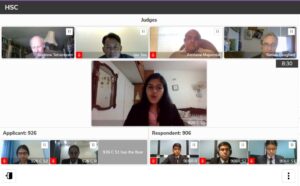
17:18: As the Counsel now advocates for the applicability of Hague Rules 1924 giving its clause paramount effect, Mr. Andrew questions her on the applicability of the English Sea Act. Mr. Simon has a similar follow-up question on the force of law of the Hague Rules. The Counsel has put up a brave face and has attempted to appease the arbitrators with a case law but Mr. Simon doesn’t look content with the answer furnished.
17:22: The Counsel has however assured that the questions posed at her would be cleared in the second limb of her argument. “Was this a deck cargo or an under-deck cargo?”, asked Mr. Amitav. The Counsel replied that the fact sheet was not transparent on the position of the cargo and has requested to proceed with her other arguments.
17:25: Owing to the myriad of questions posed to the Counsel, she has almost run out of time and has pleaded for an extension so that she can comfortably present her submissions.
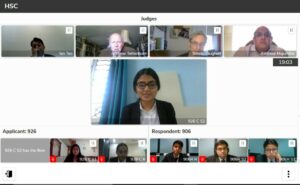
Finals- We have given you indulgence, but our indulgence is not unlimited"- Andrew Tettenborn#nluoimam
— NLUO International Maritime Arbitration Moot(IMAM) (@NLUO_IMAM) March 27, 2022
17:27: Mr. Andrew has politely pointed out to the Counsel that her time is on the verge of geting over. He says, “Though we are indulging you, our indulgence cannot be unlimited.” The Counsel is fighting tooth and nail to wrap up her arguments but she has been stopped for more clarification on the ratio of a particular judgement she cited. The Counsel pleads for an extension of 30 more seconds to complete her submissions. “Off you go”, said Mr. Simon and the Counsel has been allowed to finish up the presentation of her submissions.
17:31: The second Counsel from the claimants’ side has taken the floor now and is confidently and efficiently presenting the remaining issues. She lays out the very pertinent concept of “No Fault Liability” where the defendants are liable even when they have no fault but she points out that the defendants here despite admitting fault is claiming no liability.
17:34: The Counsel was elaborating on the term “seaworthy vessel” when she is stopped by Mr. Andrew who said that she need not convince the arbitrators on the condition of the vessel as that is well within the knowledge of the arbitrators.
17:36: The Counsel is citing a part of an article authored by Mr. Andrew himself. She is soon interrupted by Mr. Simon who wants to know the concept upon which the Counsel intends to place reliance.
Finals – The Counsel answers that the claimants intend to place reliance on both "Duty of Care of the Defendants" as well as "The Negligence under Tort Law".#nluoimam
— NLUO International Maritime Arbitration Moot(IMAM) (@NLUO_IMAM) March 27, 2022
17:40: The Counsel is referring to a pertinent case law in the memorial and is simultaneously elaborating on the precedent for the convenience of the arbitrators. “Is it the page that looks like a flowchart?”, asked Mr. Andrew cheerfully while going through the Compendium, The Counsel however directs him to the correct page.
17:44: The Counsel has now moved on to the set of arguments on liability on the part of defendants. “What do you think was the intention of the parties while incorporating clause 3 in the agreement?” The Counsel is steadily and confidently batting for the claimants’ side citing Hague Rules and is seen emphasizing on the fact that the contract is being read in toto.
17:53: The mic has been passed on to the Respondents’ side who look equally confident and fierce with their set of arguments. The first counsel is calmly arguing in favour of the application of IAA and is negating the existence of any other seat of arbitration except Singapore.
17:56: Mr. Ian questions the Counsel on the mandatory nature of section 9 of the IAA and has difficulty comprehending the mandatory nature of the same. The Counsel replies that they intend to go into the construction of the provision and interpret the intention of the drafters. Saying this, the Counsel has attempted to explain the mandatory nature of section 9.
18:00: “Why do you think the Singaporean legislature has made it so difficult to appoint more than one arbitrator and has left the number so ambiguous and open-ended?”, asked Mr. Andrew. Mr. Amitava has followed up on the question of Mr. Andrew asking, “Why can the number of arbitrators not be three under SCMA rules if the number has not been determined by the parties?” The Counsel has pointed out the default clause in section 9 and is seen elaborating on the inconsistency between Clause 8.2 and clause 9 of IAA.
18:05: The Counsel is pleading to the arbitrators and vehemently arguing on the over-riding effect of IAA over SCMA Rules. Subsequently, the Counsel submits that the Hague Rules would have no force of law at all in this particular matter.
18:07: “The Hague Visby Rules has not been asserted by the claimant so there is no dispute on this condition”, pointed out Mr. Simon and Mr. Ian. The Counsel has thus moved on to the next limb of her argument.
18:10: The Counsel has thus moved on to explaining the contractual liability of incorporating the Hague Rules through a very pertinent case law. The Counsel is additionally citing authorities authored by Mr. Simon, the arbitrator himself. This has been quite an interesting round where most of the articles cited have been authored by the honorable arbitrators themselves.
18:14: The second Counsel from the respondents’ side has been handed over the baton who is trying his best to match the energy and confidence of his co-counsel. Outlining his arguments, the Counsel has started off by explaining clause 7 of the case study. Additionally, he is seen referring to the Odysses Bill of Lading.
18:18: Mr. Andrew stops the second Counsel and asks him “Wouldn’t the term ‘ship’ here mean any ship carrying goods between Santos and Chennai?” The Counsel has been able to explain the term with accuracy emphasizing on the intention of the parties.
18:22: The Counsel is now referring to Article 15 of the Odysses Bill of Lading alongwith a case law as mentioned in the memorial. He is emphasising on the intention of the parties where the bailors and sub-contractors intended not to be exposed to liability and would therefore fall under exemption.
18:25: Article 3 Clause 8 of the first Bill of Lading comprising of the Himalayan clause seems to be a tricky part as Mr. Simon has been firing quite a few questions on it and despite the Counsel’s attempt to answer his questions, he does not look much convinced.
18:27: Nonetheless, the Counsel has been allowed to proceed to the next limb of his argument. He is seen mooting over the quantum of damages claimed by the other side. “Which limitation provisions are you relying on?” asked Mr. Simon, The Counsel replied that he was relying on the Fidalgo Bill of Lading.
18:31: This fascinating round is slowly closing down and reaching its end with the Counsel from the respondents’ side presenting the prayers. The round has reached the most intriguing peak with the rebuttal and sur-rebuttal rounds in progress.
18:34: With the start of the rebuttal rounds, the claimants’ side has started off with explaining the Saba case which was much debated upon during the entire arbitration proceedings. The claimants’ side has finally concluded the rebuttal rounds with a claim of $600000 from the respondents’ side.
18:38: The respondents’ side has been given the floor to sur-rebuttal rounds and the Counsel has clarified that they did not intend to push on the Saba case to build on their matter. As the sur-rebuttal rounds gain pace, Mr. Andrew points out that the argument made by the Counsel is more general and not very specific. With that, the Counsel of the Respondent stands down and the final round of IMAM ends on a very satisfactory note.
18:42: The judges have been sent to their respective room for deliberation and the participants are patiently waiting for the result. The feedback session is about to start. The final rounds were indeed a treat for anybody who was fortunate enough to witness it. We hope to organise an even grander IMAM competition in the year ahead.
FINAL ROUND CONCLUDES!
VALEDICTORY CEREMONY
Greetings!
The valedictory ceremony for 9th NLUO Bose & Mitra & Co. International Maritime Arbitration Moot Court Competition, is now live. Do join us live!https://t.co/3zNm5zI9Ct#nluoimam pic.twitter.com/tF1oyCQeFK
— NLUO International Maritime Arbitration Moot(IMAM) (@NLUO_IMAM) March 27, 2022
LIVE STREAMING LINK OF VALEDICTORY CEREMONY
The 9th National Law University Bose & Mitra & Co. International Maritime Arbitration Moot Court Competition 2022 has successfully come to an end. We saw enthusiastic arguments from 27 teams to make these Virtual Oral Rounds so interesting and engaging. The rounds were organized from 24th to 27th March 2022 and we have to commend the energetic display and the perseverance of the participations who were integral to make this moot a huge success. The Organizing Team of the IMAM 2022 was impeccable in its approach and we are very thankful for their efforts. We express our gratitude to the judges who took time out of their busy schedules and contributed to the quality of this moot court competition.
As it was exemplified in the finals which were concluded just now, we saw some thrilling rounds throughout the moot court competition in which there were some fantastic arguments were put forth. The judges’ interjections and questions must have helped the students to understand where their arguments were lacking and what improvements they can make in order to reach the next level of their personal growth.
This event could not have been possible without the constant support of our partners namely: our Academic Partners, The Institute of International Shipping and Trade Law, Swansea University; our Global Partners Singapore Chamber of Maritime Arbitration; our Knowledge Partner Informa Law; our Resource Partner The Asian Institute of Alternative Dispute Resolution. Furthermore, we wish to thank the administration of National Law University Odisha led by the Vice-Chancellor, Prof. Ved Kumari and the Registrar, Prof. Yogesh Pratap Singh. The support of the Faculty Advisors Ms. Eluckiaa and Ms. Nikita also played a crucial part in the success of this event. We also thank all members of the Core Committee and The Moot Society, who worked tirelessly behind the stage to make the IMAM a grand success. Last but not the least, the live blogger’s team was instrumental in the updates posted on the IMAM official website and SCC Online, the team consisted of the following members: Vishesh Minocha, Devansh Sehgal, Sagun Modi, Pratikshya Mohanty, Taniya Ghangas, Ananya Sharma, Chitrangda Saini, Anjalika Sarkar, Ananya Gudihal, Tamanna Das Patnaik, Karshana Aggarwal, Rohini Roy. On this note, we sign off on behalf of the Moot Society, National Law University Odisha.


